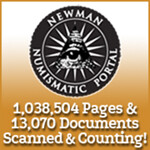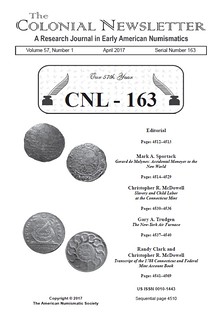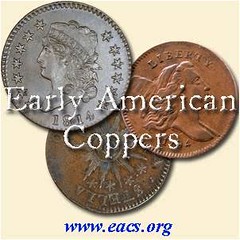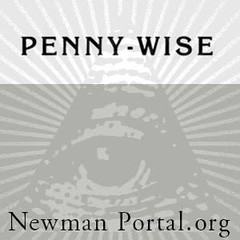
About UsThe Numismatic Bibliomania Society is a non-profit organization devoted to the study and enjoyment of numismatic literature. For more information please see our web site at coinbooks.org SubscriptionsThose wishing to become new E-Sylum subscribers (or wishing to Unsubscribe) can go to the following web page link MembershipThere is a membership application available on the web site Membership Application To join, print the application and return it with your check to the address printed on the application. Print/Digital membership is $40 to addresses in the U.S., and $60 elsewhere. A digital-only membership is available for $25. For those without web access, write to: Terry White, Treasurer
AsylumFor Asylum mailing address changes and other membership questions, contact Terry at this email address: terrywhite5475@yahoo.com SubmissionsTo submit items for publication in The E-Sylum, just Reply to this message, or write to the Editor at this address: whomren@gmail.com BUY THE BOOK BEFORE THE COINSale Calendar |
- WAYNE'S WORDS: THE E-SYLUM APRIL 9, 2017
- APRIL FOOLS ISSUE, 2017
- KOLBE & FANNING SALE 145 HIGHLIGHTS
- NEW BOOK: PERSONAL TOKENS AND MEDALS OF AMERICAN NUMISMATISTS
- BUGERT'S LIBERTY SEATED HALF BOOKS ONLINE
- COLONIAL NEWSLETTER APRIL 2017 ISSUE PUBLISHED
- BOOK REVIEW: 1792: BIRTH OF A NATION‘S COINAGE
- PHIL WOOD GREENSLET (1932-2017)
- NEWMAN PORTAL REACHES ONE MILLION PAGES
- NEWMAN PORTAL ADDS JOHNSON ENCYCLOPEDIA
- POGUE COLLECTION BRINGS OVER $106 MILLION
- THE END OF THE POGUE ERA
- NOTES FROM E-SYLUM READERS: APRIL 9, 2017
- MORE ON THE ABC'S OF ORGANIZING U.S. MINT MARKS
- JAMESTOWN COINS AND COUNTERS EXHIBIT
- CAPE COD METAL DETECTORISTS
- VOCABULARY TERM: PLAQUETTE
- SCOTT STAMP & COIN COMPANY, LTD.
- A BROAD DEFINITION OF NUMISMATICS
- DENVER MINT SUPERINTENDENT NORA WALSH HUSSEY
- THE INVENTION OF THOMAS WILFRED
- MEET THE MUDLARKS
- A CHOPMARKED COIN PROGRESSION SET
- HERITAGE OFFERS ERIC P. NEWMAN INTERNET 3 SALE
- SELECTIONS FROM THE NEWMAN INTERNET 3 SALE
- NUMISMATIC NUGGETS: APRIL 9, 2017
- 1981 ALLSTATE 50TH ANNIVERSARY MEDAL
- THE COMPUGRADE MEDAL
- PERSIA’S ACHAEMENIDAE GOLD DARIC
- DESIGNER GAULTIER CREATES FRENCH COINS
- THE U.S. TREASURY DEPARTMENT MONEY LAUNDRY
- DEFACING COINS LIKE A SUFFRAGETTE
- CONFERENCE EXAMINES COINS FOR THE DEAD
- 2016 AMERICAN MEDAL OF THE YEAR NAMED
- CANADA COMMEMORATIVE $10 NOTE UNVEILED
- NEW €50 EUROPA SERIES BANKNOTE ISSUED
- BANK OF ENGLAND £5 NOTE DEADLINE APPROACHES
- MICRO-PORTRAIT ARTIST EYES NEW POUND COIN
- ARTICLE PROFILES IMAGES OF VALUE EXHIBIT
- FEATURED WEB SITE: AMERICAN MEDALLIC SCULPTURE ASSOCIATION
Click here to access the complete archive
To comment or submit articles, reply to whomren@gmail.com
Content presented in The E-Sylum is not necessarily researched or independently fact-checked, and views expressed do not necessarily represent those of the Numismatic Bibliomania Society.
WAYNE'S WORDS: THE E-SYLUM APRIL 9, 2017
First, my apologies to any readers who have sent me articles or submissions that haven't made it into our publication yet. I've accumulated a backlog, which I dipped into this week, and still have a number of items I may not be able to get to. But please do keep sending me whatever you find of interest - I get the best content from readers like you.
This week several of our new subscribers are NBS members. I worked with our Secretary-Treasurer Terry White and added everyone he had an email address for who wasn't already an E-Sylum subscriber. Welcome aboard! We now have 3,103 subscribers. Let me know if we've added an address in error - the computers may not recognize that addresses in upper/lower case are identical.
Thank you for reading The E-Sylum. If you enjoy it, please send me the email addresses of friends you think may enjoy it as well and I'll send them a subscription with your compliments. Contact me at whomren@gmail.com anytime regarding your subscription, or questions, comments or suggestions about our content.
This week we open with an April Fools discussion, more highlights of the upcoming Kolbe & Fanning sale, a new book and one book review. Other topics this week include an important milestone and some great new content for the Newman Numismatic Portal, the Pogue collection, coins found at Jamestown and on Cape Cod, chopmarked coins, and some new banknotes.
To learn more about personal tokens and medals of American numismatists, De La Rue color samples, test bank notes, astronomer Ambrose Swasey, William Friesner, Madame Helena Petrovna Blavatski, plaquettes, the Scott Stamp & Coin Company, the Starving Time, coins for the dead, Compugrade, and the U.S. Treasury Department Laundry, read on. Have a great week, everyone!
Wayne Homren
Editor, The E-Sylum
APRIL FOOLS ISSUE, 2017
Pete Smith writes:
I have come to expect some foolery in the issue closest to April 1 each year. At first glance I was skeptical about the theft of the huge gold coin from a German museum. That story checked out.
I was reminded of my story of a Halloween party some time back. Later someone asked why that hadn't seen me at the party. I said that I came dressed as the Invisible Man.
Recalling All UK One-pound Coins
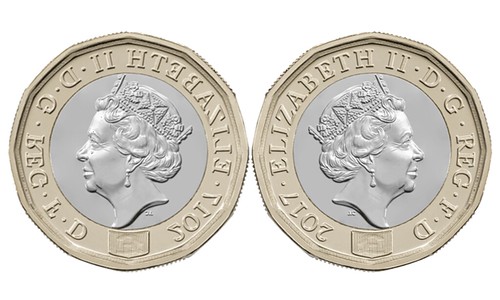
"All new £1 coins are to be recalled following a request made by The Queen, who has asked that her head is to be featured on both sides of the new 12-sided coin."
Chip Howell writes:
April Fool, I have to believe. No way she did that.
Dave Lange writes:
I believe the story about QE2 demanding her portrait appear on both sides of the pound coin is an April Fool's Day joke.
Jonathan Callaway of the UK writes:
You need to reflect on the date of the report that all new UK £1 coins are to be recalled. All reports dated April 1st need to be carefully checked!
Ron Cheek of Canada writes:
Clearly, this was originally published as an April Fool's joke. I am not sure why it got into E-Sylum. You missed April 1st by a day.
To read the earlier E-Sylum article, see:
ALL NEW £1 COINS RECALLED (www.coinbooks.org/v20/esylum_v20n14a23.html)
Invisible Coins
Andy Newman writes:
I always enjoy your E-Sylum. Naturally, I also enjoyed the April 1 report on invisible coins as well as the high-relief of the French agricultural medal.
To read the earlier E-Sylum article, see:
NEW INVISIBLE COINS ISSUED (www.coinbooks.org/v20/esylum_v20n14a27.html)
U.S.-Russia Joint Currency
Pete Smith writes:
In addition to putting Queen Elizabeth on both sides of the coin and minting invisible money, I suspect that Stvn Mnchn is not the full name of the Secretary of the Treasury and that his name will not appear on notes issued jointly by the U.S. and Russia.
Martin Purdy of New Zealand writes:
I loved the name "Lyinhisazov" in the Russian-US joint currency item - that gave me the best laugh so far today!
To read the earlier E-Sylum article, see:
U. S. AND RUSSIA ANNOUNCE NEW JOINT CURRENCY (www.coinbooks.org/v20/esylum_v20n14a28.html)
THE BOOK BAZARRE
KOLBE & FANNING SALE 145 HIGHLIGHTS
ADDITIONAL HIGHLIGHTS FROM KOLBE & FANNING’S APRIL 22 BOOK AUCTION
Kolbe & Fanning Numismatic Booksellers are holding their Sale 145 on Saturday, April 22, 2017, with the live online auction beginning at 12:00 noon Eastern Time. The 443-lot sale features selections from the libraries of Tom Cederlind, Italo Vecchi and other consignors, and includes interesting and important material on ancient, foreign and U.S. numismatics.
Some highlights of the sale include:
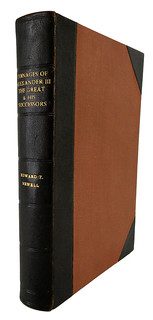
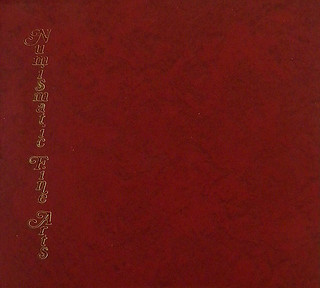
Lot 122: a bound volume of publications by Edward T. Newell, many of them quite scarce
Lot 124: a complete set of Numismatic Fine Arts catalogues, many of them hardbound
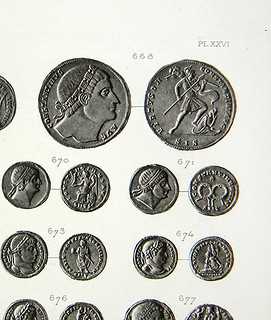
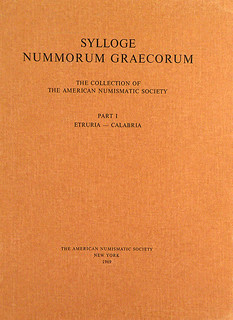
Lot 146: the Ponton d’Amécourt Roman & Byzantine sale, with fine plates
Lot 189: a complete set of the American Numismatic Society Sylloge Nummorum Graecorum series
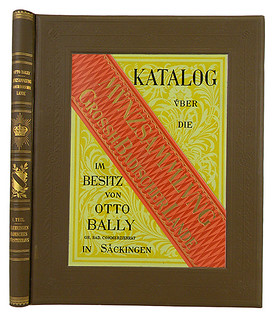
Lot 204: the rare and visually stunning Otto Bally work on Baden
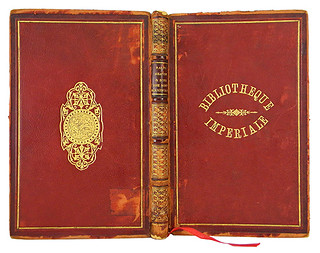
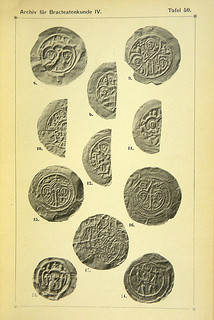
Lot 242: a rare presentation volume by Ralph Heaton & Sons of the Birmingham Mint with fine autotype plates of coins
Lot 246: a very rare complete set of the Archiv für Bracteatenkunde
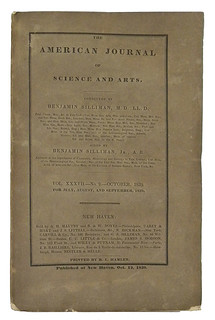
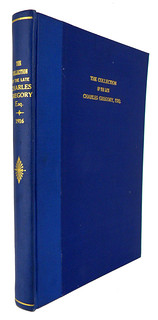
Lot 305: a rare 1839 publication on numismatics by John Allan, unlisted by Attinelli
Lot 328: a plated example of S.H. Chapman’s large-format catalogue of the Charles Gregory collection
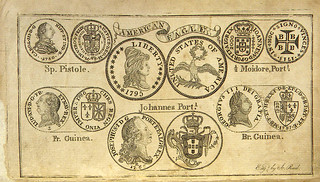
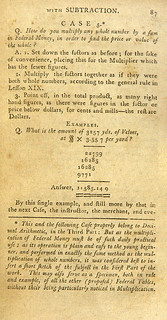
Lot 372: Chauncy Lee’s 1797 American Accomptant, featuring the earliest known illustration of a U.S. coin and the first known appearance in print of a dollar sign.
Beginning with this auction, Kolbe & Fanning is using Auction Mobility as our third-party online bidding platform. Auction Mobility is an app-based platform allowing users the ability to participate in the sale through phones, tablets and computers (though bids placed via post, email, fax or phone will continue to be accepted). To register for the sale, bidders must go to bid.numislit.com and sign up. Those wishing to participate on their devices can download the new Kolbe & Fanning app through the Apple or Google Play Store.
The printed catalogue of Sale 145 has been mailed to active customers. A PDF of the printed catalogue has been posted to the firm’s website at numislit.com for those who prefer that format. Bids may be placed via post, email, fax or phone prior to the sale. Advance absentee bids may also be placed through the online catalogue at bid.numislit.com; live internet bidding will be available during the sale itself through the same platform.
Kolbe & Fanning Numismatic Booksellers LLC is a licensed and bonded auction firm in the State of Ohio. For more information, please see the Kolbe & Fanning website at numislit.com or email David Fanning at df@numislit.com. To register for the sale, go to bid.numislit.com. We look forward to your participation.
NEW BOOK: PERSONAL TOKENS AND MEDALS OF AMERICAN NUMISMATISTS
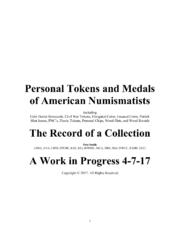 Author Pete Smith has contributed his Personal Tokens and Medals of American Numismatists to the Newman Portal. Dealer and personal tokens of numismatists are frequent “giveaways”
freely distributed at various events, and many collectors unintentionally build collections as they empty their bags at the end of a trade show. Pete Smith saw more possibility and began
systematically collecting these tokens, first issued in the 19th century.
Author Pete Smith has contributed his Personal Tokens and Medals of American Numismatists to the Newman Portal. Dealer and personal tokens of numismatists are frequent “giveaways”
freely distributed at various events, and many collectors unintentionally build collections as they empty their bags at the end of a trade show. Pete Smith saw more possibility and began
systematically collecting these tokens, first issued in the 19th century.
Personal Tokens and Medals is a 542-page record of the Smith collection, now approaching 10,000 distinct items. Among the thousands of listings are a Q. David Bowers token for his automated musical instrument business, David T. Alexander’s wedding anniversary series, and an ANA Governor candidacy medal produced by Donald H. Kagin. It is safe to say that this is largest such collection in existence, and we can all be grateful to Smith for making it available to the wider community in documentary form.
Link to Personal Tokens and Medals:
Pesonal Tokens and Medals of American Numismatists (https://nnp.wustl.edu/library/book/528986)
Len adds:
Authors interested in publishing their work on the Newman Portal may contact me at leonard.augsburger@wustl.edu .

BUGERT'S LIBERTY SEATED HALF BOOKS ONLINE
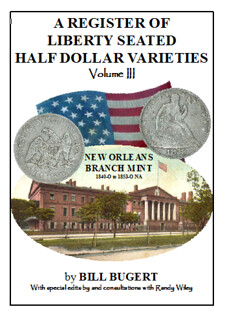 It is with great pleasure that I render the first four volumes of my Register series available to everyone for gratis use. Volumes I thru IV include details of the mintmarked die marriages
of the Liberty Seated half dollar series. They include the following:
It is with great pleasure that I render the first four volumes of my Register series available to everyone for gratis use. Volumes I thru IV include details of the mintmarked die marriages
of the Liberty Seated half dollar series. They include the following:
Bugert, Bill. A Register of Liberty Seated Half Dollar Varieties, Volume I, San Francisco Branch Mint. Gettysburg, PA: Self-published, 2009.
Bugert, Bill. A Register of Liberty Seated Half Dollar Varieties, Volume II, Carson City Branch Mint. Gettysburg, PA: Self-published, 2010.
Bugert, Bill. A Register of Liberty Seated Half Dollar Varieties, Volume III, New Orleans Branch Mint 1840-O to 1853-O NA. Gettysburg, PA: Self-published, 2011.
Bugert, Bill. A Register of Liberty Seated Half Dollar Varieties, Volume IV, New Orleans Branch Mint 1853-O WA to 1861-O. Gettysburg, PA: Self-published, 2013.
For many years, I found that carting my notes, diagrams, and/or these heavy books (Volumes III and IV each weigh over 5 pounds) around shows was impossibly cumbersome. If I ever wanted to increase interest in the Liberty seated half dollar series, this situation would have to be simplified for others. Loading these Registers onto a lightweight computer tablet facilitates easy use and quick research of die marriages at locations away from my home library such as coin shows. I have tested this technique; it works very well and saves frustration and neck and shoulder pain.
The mechanics of using these are simple. Download a copy (from http://www.lsccweb.org/BillBugertBooks/BillBugertBooks.php) and save the pdf file onto your desktop, laptop, and/or tablet. Be patient during the download; the files are very large but worth the wait. Open the file with your pdf viewer and use its functions (i.e., search, go-to, zoom-in, etc.) to navigate thru the document.
Subsequent supplements with additional die marriages (one is in the works now) will be made available for your use.
Volume V (Philadelphia Mint, 1839-1852) is not included in this listing as it is currently for sale.
COLONIAL NEWSLETTER APRIL 2017 ISSUE PUBLISHED
Mark A. Sportack
Gerard de Malynes: Accidental Moneyer to the New World
Pages 4514–4529
Christopher R. McDowell
Slavery and Child Labor at the Connecticut Mint
Pages 4530–4536
Gary A. Trudgen
The New-York Air Furnace
Pages 4537–4540
Randy Clark and Christopher R. McDowell
Transcript of the 1788 Connecticut and Federal Mint Account Book
Pages 4541–4569
Christopher McDowell adds:
This issue will feature a transcript of the 1788 Connecticut and Federal Mint Account Book along with two articles based on the 1788 records – one by me on the use of slave and child labor to produce Fugio coppers and the other authored by Gary Trudgen on the New-York Air Furnace and manufacture of the presses used to strike Fugios. This issue will also feature an article by Mark Sportack that provides a new theory regarding the manufacturer of Hogge money.
In my humble opinion, I think this is one of the most important issues of CNL ever.
For more information about The Colonial Newsletter, see:
Colonial Newsletter (http://numismatics.org/store/cnl/)
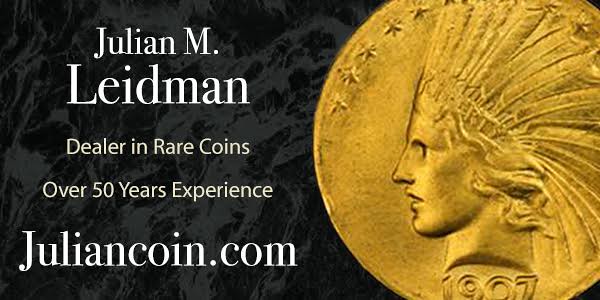
BOOK REVIEW: 1792: BIRTH OF A NATION‘S COINAGE
REVIEW: 1792: BIRTH OF A NATION‘S COINAGE BY PETE SMITH, JOEL J. OROSZ AND LEONARD AUGSBURGER
 The coinage of the United States prior to the production of the Chain cents in February and March of 1793 has long been shrouded in supposition, myth and mystery. Not any more. Smith et al.
have written a masterful, scholarly tome that sets right many misconceptions and, equally important, makes clear what can and cannot be proved. The reader will learn a lot about the who, what, where,
when and why of these historically important pieces. I am also happy to report that the authors are not above using humor when appropriate. There are many instances, and I will give only one. When
discussing evidence that Jacob Perkins was considered for the position of Chief Coiner, they comment “[i]f you read it in the newspaper it must be true.” The bits of humor here and there enlivened
the book for this reader.
The coinage of the United States prior to the production of the Chain cents in February and March of 1793 has long been shrouded in supposition, myth and mystery. Not any more. Smith et al.
have written a masterful, scholarly tome that sets right many misconceptions and, equally important, makes clear what can and cannot be proved. The reader will learn a lot about the who, what, where,
when and why of these historically important pieces. I am also happy to report that the authors are not above using humor when appropriate. There are many instances, and I will give only one. When
discussing evidence that Jacob Perkins was considered for the position of Chief Coiner, they comment “[i]f you read it in the newspaper it must be true.” The bits of humor here and there enlivened
the book for this reader.
Each of the pattern and business strike coins of the era are given full attention. If they are struck in different metals or with different edges, all subvarieties are addressed. All of the 1792 patterns are illustrated with generally good photographs, carefully described and, were possible, attributed as to their designers. But the half disme is the star. There are almost 50 pages with images and descriptions of every example the authors could trace. They are the commonest and the only coins from that year that, as shown by the authors, were intended to be spent. Thus, they were the first US circulating coinage, and they weren’t made from Martha Washington’s silver.
The book also addresses the people involved or believed to be involved. Sections discuss who was considered for each of the Mint officer positions. Even many of the Mint’s laborers in 1792 and 1793 are identified, though not all. Jacob Bay is given slightly short shrift as just a maker of punches. He was also a coiner of many of the Wreath cents and probably the Chains as well. Joseph Wright is given a fairly brief discussion, which is consistent with the fact that probably all he ever did for the Mint was engrave the dies for the Henry Lee medal. Too many previous works give Wright credit for much that he obviously did not create, from various 1793 cent types, to the Libertas Americana medal to the 1794 dollar, which was engraved many months after his death. In early 1794, his estate received $233.33 (=50 Guineas) for the Lee medal. That is the only record of him receiving any pay from the government.
The book is not just about the coinage at the Mint in 1792. Three chapters are devoted to the Washington Cent coinage, much of which dates from 1791. Another four chapters are devoted to the 1792 pattern coinage and the half dismes, which the authors show clearly were (at least mostly) struck to be circulating coinage. Half dismes receive a LOT of attention, and you will learn a great deal about them. I certainly did. When and how they were made, who owned them, how many are preserved, their current grades and a historical price guide. A price guide is in Appendix III, and I was prepared to be horrified by seeing a current price guide of the Red Book type. Instead, the appendix shows auction price ranges over the full grade range from 1859-2016. I’d call it a price history rather than a guide. Well done.
While it is written in an accessible style for such an historic tome, there is no lack of good scholarship. The authors quote numerous contemporary (and not so contemporary) letters and legislation at length. The reader will refer to 15 pages of endnotes and an extensive index. Again, well done.
There are chapters about 1792 coins in popular culture – yes, there are novels that feature the coins. Two chapters address replicas and fantasies, mostly focusing on replicas by Dickeson and The Gallery Mint Museum as well as Chinese fakes.
I confess that I was also concerned by the title, having watched D.W. Griffith’s masterpiece of racist and revisionist cinematography, Birth of a Nation. I suspect that the authors thought of (intended?) the similarity, because the front cover shows a painting of Jefferson giving the first half disme to an African-American porter. Coincidence? Nah.
My only complaints are exceedingly minor: some of the diagrams required a glass to be read, but the quality of the images was such that I could read them that way.
I was eagerly anticipating the appearance of this book and am delighted to say that it did not disappoint. With 320 meaty pages plus 32 more of appendices, endnotes and an index, there is a great deal to digest. Fortunately, the writing style is such that you’ll enjoy the feast. If you have any interest at all in the earliest experimental efforts at setting up a Mint in Philadelphia, and especially if you like to see real data dispel supposition, myth and mystery, you need to buy and read this book.
To read the earlier E-Sylum article, see:
NEW BOOK: 1792: BIRTH OF A NATION'S COINAGE (www.coinbooks.org/v20/esylum_v20n13a02.html)
For more information, or to order, see:
1792: Birth of a Nation's Coinage (softcover)
(https://coins.ha.com/itm/books/1792-birth-of-a-nation-s-coinage-softcover-/i/960011813.s)
PHIL WOOD GREENSLET (1932-2017)
Phil Wood Greenslet, 84, died on April 1, 2017. He was born in Cochranton, PA, on May 6, 1932. He earned a BA from West Virginia Wesleyan College in 1954 and an MA from Emory University in 1955. Following graduate school, he served with the US Army in Heidelberg, Germany, where he met his future wife, Myra. Together, they raised four children. Phil worked over forty years in retail management before retiring.
Phil was an avid collector and exhibitor, specializing in medals of Benjamin Franklin and military decorations. His exhibits won countless awards at local, regional, national, and international conventions. He wrote the definitive reference on medallic portraits of Benjamin Franklin; The Medals of Franklin was published by the Token and Medal Society in 1993. In addition, Phil held numerous positions in Maryland numismatic organizations, and he was instrumental in bringing the ANA’s annual convention to Baltimore in 1985. He served as exhibits chairman at the 1985 ANA convention and the 1991 ANA convention in Chicago.
Phil is survived by his four children and one grandson.
To read the Baltimore Sun obituary, see:
Phil Wood Greenslet
(www.legacy.com/obituaries/baltimoresun/obituary.aspx?n=phil-wood-greenslet&pid=184825324&)
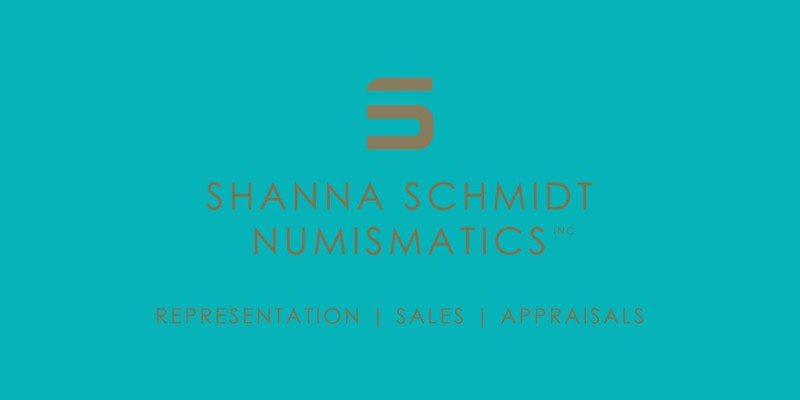
NEWMAN PORTAL REACHES ONE MILLION PAGES

The Newman Numismatic Portal (NNP) has reached a milestone of one million scanned pages, representing over 13,000 documents. The million mark was exceeded in March 2017 during the scanning of the extensive run of Stack's Bowers auction sale catalogs. This particular series begins in 1935 and includes nearly 800 sales, of which 99% have now been scanned. The Newman Portal acknowledges Stack's Bowers for sharing this content and for allowing it to be made freely available through NNP. We also thank our scanning partners at the American Numismatic Society (ANS), Librarian David Hill and Internet Archive associate John Graffeo, who scanned many of the early catalogs in this extensive series. Finally, ANS Trustee Dan Hamelberg made available Stack's material form his unparalleled library.
Link to Stack’s Bowers catalogs on NNP:
https://nnp.wustl.edu/library/auctioncompanydetail/3
NEWMAN PORTAL ADDS JOHNSON ENCYCLOPEDIA
Newman Portal and D. Wayne Johnson Collaborate on Encyclopedia of Coin and Medal Technology
 The Newman Numismatic Portal (NNP) and D. Wayne Johnson are pleased to announce the Newman Portal has been selected as the online platform for Johnson’s Encyclopedia of Coin and Medal
Technology. Content from Johnson’s Encyclopedia has been integrated into the NNP Dictionary, introducing authoritative and concise entries of nearly two thousand terms related to the design,
manufacture, collecting and curating of coins and medals. Johnson will continue to oversee the Encyclopedia content in its online form, adding additional entries and developing illustrative
material necessary to clarify technical aspects of medallic development.
The Newman Numismatic Portal (NNP) and D. Wayne Johnson are pleased to announce the Newman Portal has been selected as the online platform for Johnson’s Encyclopedia of Coin and Medal
Technology. Content from Johnson’s Encyclopedia has been integrated into the NNP Dictionary, introducing authoritative and concise entries of nearly two thousand terms related to the design,
manufacture, collecting and curating of coins and medals. Johnson will continue to oversee the Encyclopedia content in its online form, adding additional entries and developing illustrative
material necessary to clarify technical aspects of medallic development.
Johnson said “I envision this project as a living thing. It has the advantage of being easily modified and brought up-to-date as new technology becomes apparent in the minting field, or when numismatists originate new terms in describing specimens.” Len Augsburger, Newman Numismatic Portal Project Coordinator, added “We are excited to host the Encyclopedia on the Newman Portal. Johnson has been an enthusiastic scholar in the field since the 1950s and we are privileged to share his work with the greater public.”
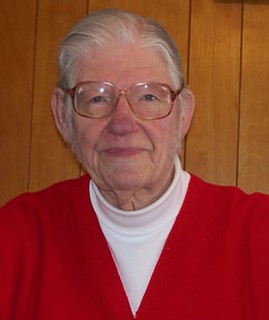 The first editor of Coin World, D. Wayne Johnson is a recognized authority on medallic technology and former Director of Research at the Medallic Art Company. He has published two
books and more than 1,500 articles in the field and overseen the development of numerous privately-struck medals, including the Eric P. Newman Centennial Medal. Johnson is a founding member of the
Rittenhouse Society, a group created in the late 1950s in response to a growing need for original research in American numismatics.
The first editor of Coin World, D. Wayne Johnson is a recognized authority on medallic technology and former Director of Research at the Medallic Art Company. He has published two
books and more than 1,500 articles in the field and overseen the development of numerous privately-struck medals, including the Eric P. Newman Centennial Medal. Johnson is a founding member of the
Rittenhouse Society, a group created in the late 1950s in response to a growing need for original research in American numismatics.
In addition to collectors, the Encyclopedia will serve researchers, writers, and particularly catalogers who will find the exact term to describe die-struck numismatic items, including coins, medals and tokens. Each entry defines the term followed by a paragraph or more of basic information in the development of the term; 55 entries are more than a thousand words in length.
The Newman Numismatic Portal (NewmanPortal.org) was launched in November 2014 by the Eric P. Newman Numismatic Education Society (EPNNES) with the purpose of making numismatic literature and images available on a free and forever basis to numismatic and other communities. The Portal’s collection of over 13,000 documents now represents the largest online American numismatic library. The Newman Portal is administered by Washington University in St. Louis through a grant from EPNNES. Newman, Johnson, and Augsburger are all graduates of Washington University.
Link to sample entry (“modeling”) from the Johnson Encyclopedia on the Newman Portal:
https://nnp.wustl.edu/library/dictionarydetail/516345
Dick Johnson is visionary organizer, responsible for some important firsts in the American numismatic sphere. When he became the first editor of Coin World, advertising in coin publications was typically in plain text, usually just listing coins for sale. He encouraged graphic images in Coin World ads, for a time even giving discounts for graphics to encourage more visually attractive display ads.
There were typically only three categories of classified ads in prior publications: Coins for sale, Wanted and For Trade. Dick created a system of more than fifty classifications that still exist in the publication today, although some have dropped out and others have been added, such as Bullion Coins.
He was the first director of research for Medallic Art Company and created a system for cataloging medals. His concept was a photograph of the medal on a 3 x 5 card, along with basic data. Previously the company had four numbering systems. He unified this to one system incorporating the year and a serial number. Thus all the company files – shop records and correspondence were filed with this number. The dies, die shells, models and archive medals were all given this same catalog number.
This was all back before personal computers. The data on his 3 x 5 cards were digitized by new management and his system is still in use today. His penchant for gathering and organizing numismatic data has been a constant through the decades, and his massive Encyclopedia is only his latest product. -Editor
Dick adds:
The Encyclopedia of Coin and Medal Technology is the core of a larger concept. I envision a "Wikipedia of Numismatics", where entries for single words or terms cover all aspects of numismatics. These would include: people’s names, denominations, mints, issuing countries, types of numismatic items and much more, with illustrations.
This can all be on the internet for easy access by anyone to answer most any question without cost. The Newman Portal is the ideal platform for such a massive collection of data.
My Encyclopedia is the first step for achieving such a useful databank. Like its model, Wikipedia, it will be a living thing, with new data added constantly.
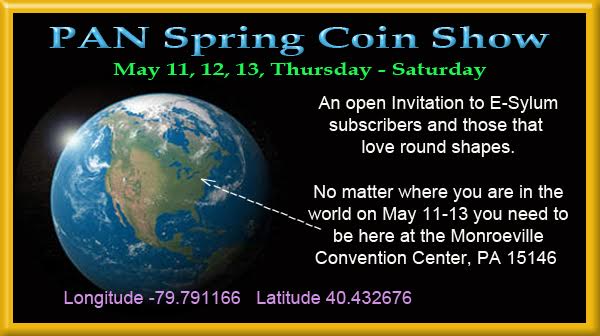
POGUE COLLECTION BRINGS OVER $106 MILLION
Fifth Sale Nets Over $21 Million for 232 Coins
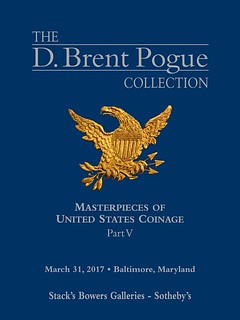 Setting a new world record for the most valuable numismatic cabinet ever sold, and perhaps a new world record for any holding of collectibles in any field, the D. Brent Pogue Collection
netted total sales of $106,720,432.25 over the course of five auction events held from 2015 to 2017 by Stack’s Bowers Galleries of Santa Ana, California and Sotheby’s.
Setting a new world record for the most valuable numismatic cabinet ever sold, and perhaps a new world record for any holding of collectibles in any field, the D. Brent Pogue Collection
netted total sales of $106,720,432.25 over the course of five auction events held from 2015 to 2017 by Stack’s Bowers Galleries of Santa Ana, California and Sotheby’s.
Tonight’s fifth auction yielded sales of $21,402,213.75, highlighted by the Dexter specimen of the legendary 1804 dollar, which brought just under $3.3 million. The Pogue Collection, assembled by father and son Mack and Brent Pogue over the course of more than three decades, focused on the highest quality United States coins dated from 1793 to 1840.
Outside of the famous 1804 dollar, one of the most legendary rarities in any American collecting field, the sale was led by the finest known specimen of the 1811 half cent, graded MS-66 RB (PCGS), which brought $998,750 in fevered bidding. A Sheldon-13 1793 Liberty Cap cent graded AU-58 (PCGS) and featured on the famous 1869 Levick Plate, brought $940,000, making it the most valuable circulated cent ever sold.
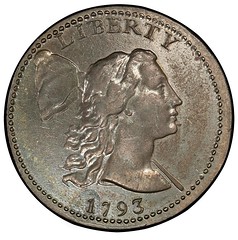
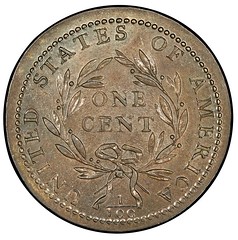
The two 1793 Liberty Cap cents included in tonight’s auction brought a combined $1.316 million, more than 65 million times their face value. The total face value of the cents in the sale, the highest quality group of early United States cents ever sold in a single auction, was $1.42. They brought a total of $12,026,653.75, nearly 8.5 million times their value as pocket change.
Other highlights included one of four known Original Proof 1852 half cents, graded Proof-65 RD (PCGS); considered the finest of the four, the Pogue specimen brought $493,500. A gem MS-65 (PCGS) 1801 dollar, once the property of Col. E.H.R. Green and Amon Carter, sold for $399,500, and an 1802 Restrike dollar in Proof-64 (PCGS) realized $352,500. Early date cents brought extremely strong prices, including those dated 1794 (the finest known 1794 Head of 1793 at $540,500 and the finest known Sheldon-24 “Apple Cheek” in magnificent PCGS MS-67 RB at $446,500), 1796 (the stunning 1796 Sheldon-84 Liberty Cap in PCGS MS-66+ RB at $705,000 and the highest graded 1796 Draped Bust cent, certified as MS-66+ BN by PCGS, at $329,000), 1799 (the finest known of the date, graded MS-61 BN by PCGS, at $540,500), and 1804 (also the finest known of the date, graded MS-63 BN by PCGS, sold for $540,500). The 1823 Newcomb-2 cent graded MS-66 BN (PCGS) brought a new record for any example of the Matron Head type, realizing $376,000. That record was tied just a few minutes later when the finest known 1839/6 cent, graded MS-65+ BN (PCGS), brought the same sum.
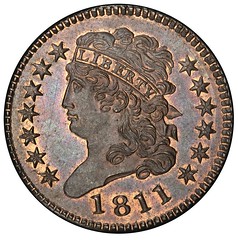
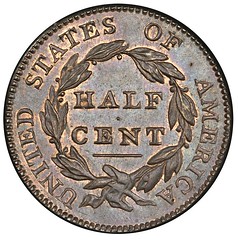
The auction was strong beyond the most notable and most expensive pieces. An 1817 15 Star cent in MS- 65 BN (PCGS) sold for $76,375, only slightly more than an 1824 N-2 graded MS-66 RB (PCGS) that brought $70,500. The same price was paid for the finest known 1826/5 cent, graded MS-66 BN (PCGS), while an 1831 N-3 in MS-66+ RB (PCGS) stunned onlookers at $105,750, a new record for the date. A MS-66 RD (PCGS) 1852 N-22 wowed those present as it sold for $94,000, leading all late date cents sold. The most expensive Liberty Seated coin sold in the sale was the MS-65 (PCGS) 1839 No Drapery half dollar, from the Lawrence Stack Type Set, that found a new home at $141,000.
“The Pogue Collection sale was a phenomenal success. Part V surpassed our highest estimates by more than $3 million, and dozens of coins set new world records for examples of their date,” said Stack’s Bowers Galleries President Brian Kendrella.
For more information, see:
www.stacksbowers.com
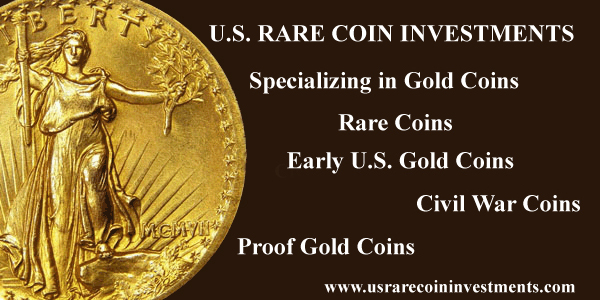
THE END OF THE POGUE ERA
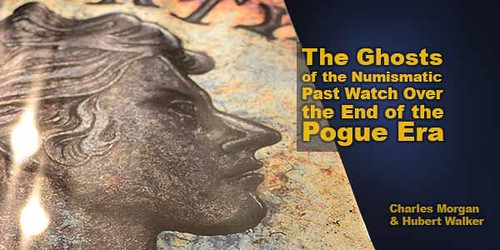
At about 11 pm it was all over - the end of a journey.
A journey that, for the Pogue family, lasted 35 years, and for collector D. Brent Pogue, spanned the entirety of his adult life.
The collection, which now stands as the most valuable coin collection ever assembled, was built the old-fashioned way: with study, professional representation and attendance at many of the great auctions of this era.
Texas real estate tycoon Mack Pogue and his son Brent were the duo behind the collection. They burst onto the scene after a stunning debut at Bowers & Ruddy’s sale of the Garrett Collection, when a teenaged Brent laid down $250,000 for two coins. He was all smiles in Jim Lowney’s photo of him holding one of his prized coins in the December 1980 issue of CoinAge.
This proved to be one of only a few times that the family sought the numismatic limelight.
Of course, the father and son Pogues were a known quantity in high-end collecting circles and amongst the industry’s leading figures. Self-promoters they did not feel the need to be.
To read the complete article, see:
The Ghosts of the Numismatic Past Watch Over the End of the Pogue Era
(www.coinweek.com/auctions-news/ghosts-numismatic-past-watch-end-pogue-era/)

NOTES FROM E-SYLUM READERS: APRIL 9, 2017
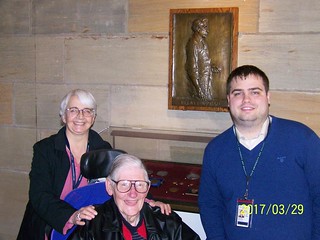 Yale's Bela Lyon Pratt Plaque
Yale's Bela Lyon Pratt Plaque
Regarding the Bela Lyon Pratt plaque mentioned in Dick Johnson's article about his visit to the Yale Art Museum, Tony Terranova writes:
I must say thank you to Dick Johnson, for inspiring me to sell that plaque to Yale. It looks a lot more appropriate on exhibit there.
To read the earlier E-Sylum article, see:
DICK JOHNSON VISITS THE YALE ART MUSEUM (www.coinbooks.org/v20/esylum_v20n14a16.html)
Greetings from Indonesia
Bernard Olij of Malang, Indonesia writes:
Thanks for all your interesting news every week!
A. Bernard Olij (Dutchman by birth)
Are the Off-Color Palestinian Notes Samples?

Jonathan Callaway writes:
I started receiving your weekly email some time ago and although I am UK based and a paper money rather than coin enthusiast I find something of interest in most of them. I look forward to continuing to receive The E-Sylum.
In the press release on the Palestinian colour trials in the DNW sale, I wish to correct one point: it is correct to say that colour trials come before production starts, allowing the issuer to decide on the preferred colour before the note enters circulation. However, there are other reasons for notes to be prepared in non standard colours and one of these applies in this case – these notes were prepared for commercial purposes by Thomas De La Rue to go in specimen books carried by their sales teams, essentially for advertising purposes. These books contained a selection of notes in non standard colours to ensure they were not misused and of course all were annotated SPECIMEN OF NO VALUE. So they were produced after and not before the notes in the correct colours had entered circulation.
Jonathan adds:
The numbers on specimen and colour trials like this are simply control numbers used by De La Rue. I have seen them run to well over 200 but as mentioned before the notes were used for various purposes not just in specimen books for advertising / sales purposes.
To read the earlier E-Sylum article, see:
DIX NOONAN WEBB OFFER RARE PALESTINIAN BANKNOTES (www.coinbooks.org/v20/esylum_v20n14a24.html)
On the Washington Market Chowder Club Medal
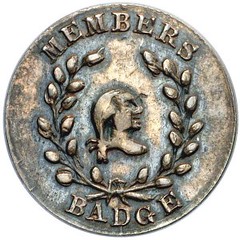
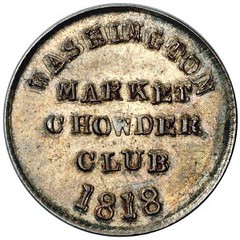
Regarding last week's item mentioning the Washington Chowder Club medal, Roger Siboni writes:
Once again...amazing! I own one of the very few Washington Chowder Club Medals and have debated its origin with many. What a fabulous bit of information. Musante thinks it was made by Charles Wright at the beginning of his career because a few stylistic things and he started his work in that same district. I have a new project to work on.
What a great find!
Thanks so much for what you do!
To read the earlier E-Sylum article, see:
1818 WASHINGTON MARKET CHOWDER CLUB TOKEN (www.coinbooks.org/v20/esylum_v20n14a19.html)
The Power of Numismatic Nuggets
Chris Bower of Indiana writes:
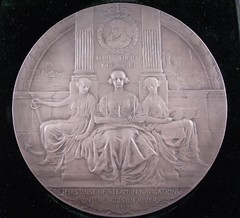 Keep the Numismatic Nuggets coming. You featured a Hudson-Fulton medal a few weeks ago. It inspired me to do some research, and found that they were made in numerous varieties. I ended up
purchasing one of the 102mm examples. It wasn't the one you mentioned but identical in pretty much every way. I also just purchased an ANS publication on there medals because this piece is one of
theirs. See what you started?
Keep the Numismatic Nuggets coming. You featured a Hudson-Fulton medal a few weeks ago. It inspired me to do some research, and found that they were made in numerous varieties. I ended up
purchasing one of the 102mm examples. It wasn't the one you mentioned but identical in pretty much every way. I also just purchased an ANS publication on there medals because this piece is one of
theirs. See what you started?
To read the earlier E-Sylum article, see:
NUMISMATIC NUGGETS: FEBRUARY 19, 2017 : 1909 Hudson Fulton Celebration Medal (www.coinbooks.org/v20/esylum_v20n08a21.html)
Assay Commission Member Ambrose Swasey
Dave Lange writes:
I was reading a website entry about astronomical observatories, and I saw mention of Ambrose Swasey. I immediately recognized his name as a person who had obtained two matte proof, low-relief 1922 Peace Dollars directly from George Morgan when struck. Swasey had been a member of the 1922 Assay Commission, providing him to opportunity to obtain the very precious dollars. These coins appeared as lots 3932 and 3933 in the Bowers & Merena catalog of the Norweb Collection, Part III, 1988, and a photo of Swasey is on page 377 of that catalog.
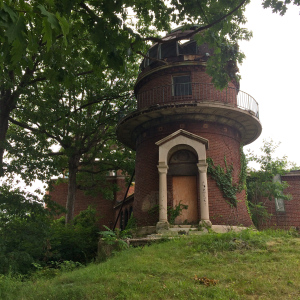 The astronomical connection is that the partnership of Worcester Reed Warner and Ambrose Swasey manufactured telescopes, among other instruments, in Cleveland a century ago. The Warner &
Swasey Company had built a private observatory in East Cleveland that was later donated to what is now Case Western Reserve University, this occurring right around the same time as Swasey acquired
the rare proofs. Unfortunately, that observatory is now abandoned and falling into ruin. The observatory website has no mention of coins, of course, but it was fun to make a numismatic
connection.
The astronomical connection is that the partnership of Worcester Reed Warner and Ambrose Swasey manufactured telescopes, among other instruments, in Cleveland a century ago. The Warner &
Swasey Company had built a private observatory in East Cleveland that was later donated to what is now Case Western Reserve University, this occurring right around the same time as Swasey acquired
the rare proofs. Unfortunately, that observatory is now abandoned and falling into ruin. The observatory website has no mention of coins, of course, but it was fun to make a numismatic
connection.
For more information, see:
OBSERVING SPACE & TIME (https://bambisoapbox.com/2014/08/10/observing-space-time/)
The New Netherlands Coin Company
Regarding a note about John J. Ford in the story on Wayte Raymond, Tony Terranova writes:
New Netherlands coin company was owned by the Wormser family. John Ford worked there.
To read the earlier E-Sylum article, see:
WAYTE RAYMOND (1886-1956) (www.coinbooks.org/v20/esylum_v20n13a14.html)
Notes From Dennis Forgue
Dennis Forgue writes:
Two things on the March 26, 2017 issue. The Dexter 1804 Dollar posters article was interesting, as the auctioneer in the 1989 sale I was given poster #990 by Mark representing the record price the dollar brought.
Also, in regards to artist Frank Lapa, I remember him painting in his show room on Madison street in Chicago in the early 1960's. He had the most modern showroom around. He was very knowledgeable and had a very mercurial temper. When you went in you did not know whether he would make you a great deal on anything you were interested in or scream at you to get out.
To read the earlier E-Sylum articles, see:
DEXTER 1804 DOLLAR POSTERS OFFERED (www.coinbooks.org/v20/esylum_v20n13a07.html)
NUMISMATISTS WHO WERE ALSO PAINTERS (www.coinbooks.org/v20/esylum_v20n13a10.html)
Counterfeit Confederate ID Disc
This week I sent researcher Peter Bertram a link to a "Confederate Medal" being offered in an online auction. Peter replied that it was "a decorative type item based on the Confederate Great Seal and follows the merchandise mentioned in my book pg 111, last paragraph of text".
He added that he looked through the rest of the auction and found a counterfeit Confederate ID Disc - one of those he describes in the last section of his book "Confederate Numismatica, Part 1". Peter wrote that he emailed and called them about it and now reports that it's no longer in the auction and concludes "kudos to http://www.invaluable.com/auction-lot/-1-c-BA64847B98 for doing the right thing!"
Peter's book is available on his website at www.ConfederateNumismatica.com . -Editor
More on Collecting By Mint Marks
Michael Marotta writes:
Thanks for reposting Len Augsburger's E-Gobrecht review of Mint Marks by A. G. Heaton. I have an edition reprinted by Bowers and Merena Galleries in 1987. It was a run of 2000. In his Introduction, Q. David Bowers covers many of the same facts as Len. However, Bowers identifies the 1909-S VDB cent as the impetus for our passion for Mint marks.
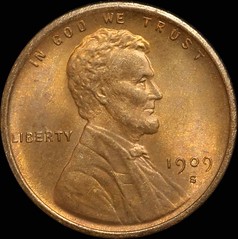 "In 1908 the San Francisco Mint produced cents for the first time, thus creating the first mintmarked copper coinage. The next year, 1909, saw the advent of the the Lincoln cent.
Immediately upon their release, the new coins were popular, and Philadelphia issues quickly commanded a premium. It was publicized that even more desirable were 1909 San Francisco Lincoln cents
bearing the initials of the designer, V.D.B. (for Victor David Brenner.) A mad scramble ensued, and 1909-S V.D.B. cents rose spectacularly in value. ... Interest in mintmarks had been growing, and
once word of the rare 1909-S V. D. B. cent spread, no further incentive was needed for collectors to pay attention to mint letters."
"In 1908 the San Francisco Mint produced cents for the first time, thus creating the first mintmarked copper coinage. The next year, 1909, saw the advent of the the Lincoln cent.
Immediately upon their release, the new coins were popular, and Philadelphia issues quickly commanded a premium. It was publicized that even more desirable were 1909 San Francisco Lincoln cents
bearing the initials of the designer, V.D.B. (for Victor David Brenner.) A mad scramble ensued, and 1909-S V.D.B. cents rose spectacularly in value. ... Interest in mintmarks had been growing, and
once word of the rare 1909-S V. D. B. cent spread, no further incentive was needed for collectors to pay attention to mint letters."
Thanks. I think there's truth to both explanations of the jump in interest in collecting by mint marks. The Heaton book got the attention of serious collectors and dealers, and the 1909-S cents got the attention of the general public. Once both elements were in place, there was no going back to the days when mint marks were not seen as important. -Editor
William Friesner
In the review of A. G. Heaton's book on branch mint coins, It mentions the Frossard sale of the Wm. Friesner collection. Professor Friesner was the superintendent of public schools of Los Angeles, and an early ANA member. Unfortunately he was stricken with tuberculosis, for which at that time there was no cure. It took his life at age 43.
He wrote to Dr. Heath in a matter of fact way that one lung is two thirds, and the other one third gone. Dr Heath paid him tribute by writing,
"History tells of martyrs for country, for religion, but none ever went to the lions, to the stake, or the battlefield with greater fortitude than he, who with mental faculties acute, calmly sits down with death and bids the grim tyrant he can no longer defy to sup with him."
To read the earlier E-Sylum article, see:
BOOK REVIEW: HEATON'S TREATISE ON MINT MARKS (www.coinbooks.org/v20/esylum_v20n14a05.html)
More On Lyman Low
Dave Hirt adds:
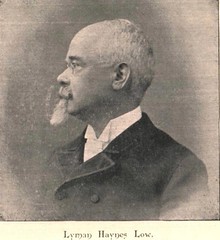 In the post about Lyman Low describing his numismatic life, it is interesting that the first coin sale he attended in NYC, the Theodore Riley sale was the 71st and last sale of pioneer
dealer Edward Cogan. The May 1924 Elder sale of the Low collection also contained Low's extensive numismatic library, and, as might be expected of a civil war veteran, a collection of GAR badges
and medals, which Elder called the finest in existence.
In the post about Lyman Low describing his numismatic life, it is interesting that the first coin sale he attended in NYC, the Theodore Riley sale was the 71st and last sale of pioneer
dealer Edward Cogan. The May 1924 Elder sale of the Low collection also contained Low's extensive numismatic library, and, as might be expected of a civil war veteran, a collection of GAR badges
and medals, which Elder called the finest in existence.
To read the earlier E-Sylum article, see:
LYMAN HAYNES LOW (1844-1924) (www.coinbooks.org/v20/esylum_v20n14a13.html)
The National Bibliomania Society
Pete Smith writes:
Today (April 4) I received my copy of the April issue of The Numismatist. On page 76 I noticed an obituary for Dr. Thomas Fitzgerald. Among club membership listed, he was a member of the "National Bibliomania Society."
Pete adds:
Perhaps after his membership in the Numismatic Bibliomania Society expired, he maintained his membership in the National Bibliomania Society.
Beauty and the Beast
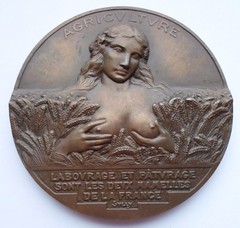
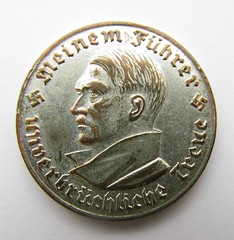
Eric Hodge writes:
Thank you again for another thought provoking numismatic weekly nugget.
I am in France at the moment, where the film getting all good reviews is Beauty and the Beast. You could not have encapsulated the idea better than with the two medals displayed. First the French Agricultural Medal - what can one say, and second the 1934 NSDAP Hall of Honour Medal. Which is which?
To read the earlier E-Sylum article, see:
NUMISMATIC NUGGETS: APRIL 2, 2017 (www.coinbooks.org/v20/esylum_v20n14a17.html)
On the Paris Mint's French Agriculture Medal

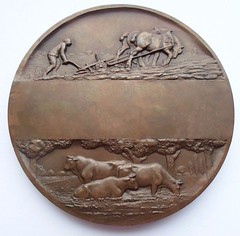
Regarding the French Agriculture medal pictured in last week's Numismatic Nuggets article, Dick Johnson writes:
“Obverse: bust of nude woman figuring Agriculture.”
What was the name of the other one?
Funny you should ask. Serge Pelletier of Canada writes:
I thought some of the E-Sylum readers may be interested in the text of the obverse: Ploughing and Grazing are the two teats of France.
That explains a lot - now the medal makes a lot more sense.
This wasn't what I had in mind when I named the articles "Numismatic Nuggets", but what the heck. Let's just keep the discussion PG-13. The medal sold for $250. Did one of you pervs out there buy it? -Editor
To read the earlier E-Sylum article, see:
NUMISMATIC NUGGETS: APRIL 2, 2017 : French Agriculture Medal (www.coinbooks.org/v20/esylum_v20n14a17.html)
THE BOOK BAZARRE
MORE ON THE ABC'S OF ORGANIZING U.S. MINT MARKS
Regarding the sequencing of mints in Whitman publications transitioning from P-S-D to P-D-S, this was an industry-wide phenomenon that occurred in the early 1960s. All numismatic books previously had listed the mints in order of their authorization date, as this is how they appeared in U. S. Mint documents and publications. Wayte Raymond was just one of the many authors/publishers who continued this sequencing. The same is true for coin albums and folders, nearly all of which read P-S-D until the early '60s.
I was able to determine that the conversion to P-D-S sequencing occurred in 1961. That is shortly after Ken Bressett joined the company, though I don't know whether he had any influence in making the decision.
Whitman's line of green, All-in-One folders, printed 1958-64, likewise comes both ways, though only the ones for cents through dimes are found with both versions. The higher denomination folders were introduced after the transition date. Whitman's line of Bookshelf albums, which debuted in 1961, are found only with the P-D-S sequence. I'm not certain when the conversion occurred for the Red Book and Blue Book, as I sold my collections of these years ago.
Whitman may have been driven to revise its mint sequence from the competition offered by The Coin and Currency Institute's new line of Library of Coins albums. Introduced in 1959, these used a P-D-S sequence that was unique at the time. All new lines of coin albums published after 1961 used this same sequence. As the "P" was actually omitted on both the coins and the albums, the new sequence was purely alphabetical and thus more easily understood by new collectors. For older coin series, the full sequence became P-CC-D-O-S.
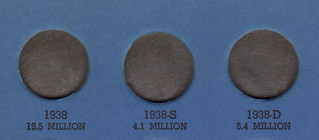
Whitman Jefferson PSD - 1959
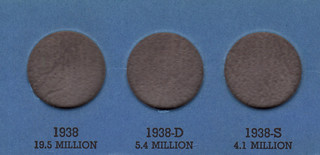
Whitman Jefferson PDS - 1960
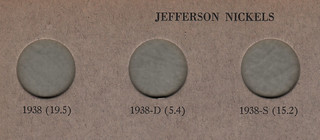
Dansco PDS - 1940
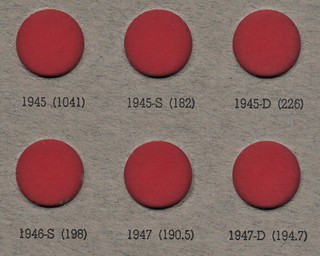
Dansco Mixed - 1956
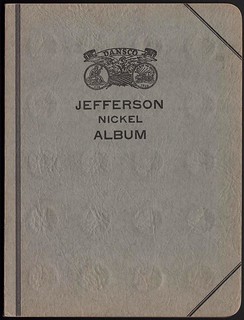
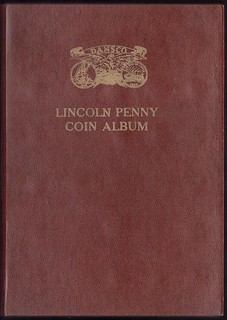
Left: Dansco Bound No. 19
Right:Dansco Deluxe No. 100
As so often happens when I examine my folders that have not already been published as a book, I find that my informal notes are slightly erroneous. As the attached images of blue Jefferson Nickel folders reveal, Whitman transitioned from PSD to PDS in 1960, not 1961. This is determined by the final printed mintage figures, which are 1958 and 1959, respectively. What remains true is that Whitman, which was not particularly innovative in its folders and albums, changed the sequence in response to the great popularity of the Library of Coins albums.
Another interesting point is that Dansco, which in 1939 was the first company to print coin folders, used the PDS sequence at that time and was the only publisher doing so. The first image is of a folder from its Dansco Bound Line (1939-70) printed in 1940 that uses this sequence. The second image is of a folder in its Deluxe line, which debuted in 1955 and is still in print today. This example is from 1956, and it features a most interesting oddity. The Lincoln Cents are sequenced PSD from 1911 through 1945, at which point they become PDS in the same folder! This was later straightened out by the publisher, but it's one of the many inconsistencies that make early Dansco folders so fun to collect and so maddeningly difficult to catalog.
To read the earlier E-Sylum article, see:
NOTES FROM E-SYLUM READERS: APRIL 2, 2017 : The ABCs of PDOS (www.coinbooks.org/v20/esylum_v20n14a09.html)
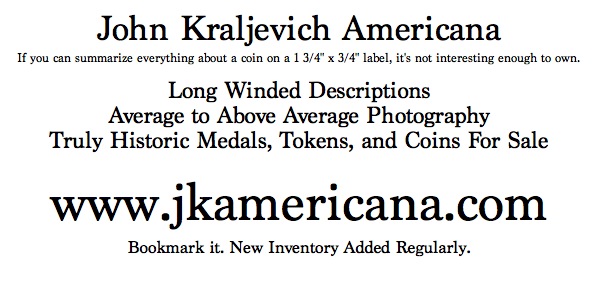
JAMESTOWN COINS AND COUNTERS EXHIBIT
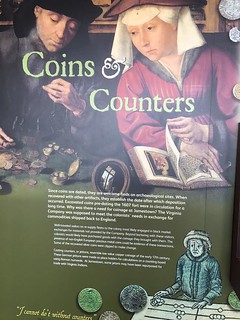
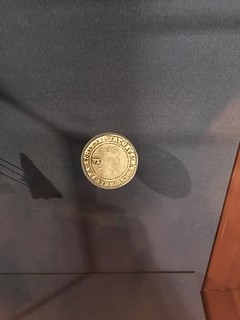
Jeff writes:
This was the museum at the Jamestown settlement called the Archaneum museum. The building holds the excavated finds from the Jamestown settlement -- from pre-contact native artifacts to a surprising number of things from the first decades including named clay pipes, pottery, armor, a couple of skeletons and a skull that shows pretty clear marks of cannibalism from the Starving Time. The coins take up a single case, but it's informative and touches on why they were used,as well as the Nuremberg jetons that were something of a surprise.
It's nice to know some places take coins seriously and understand their importance. Jamestown is one such place, but it was a bit unexpected to see so many coins found at the site since I thought most trade was done by exchange! But there were ships from elsewhere in Europe that came here too, and coins from all over.
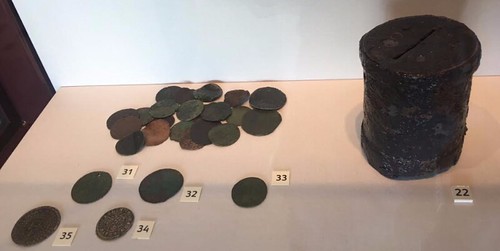
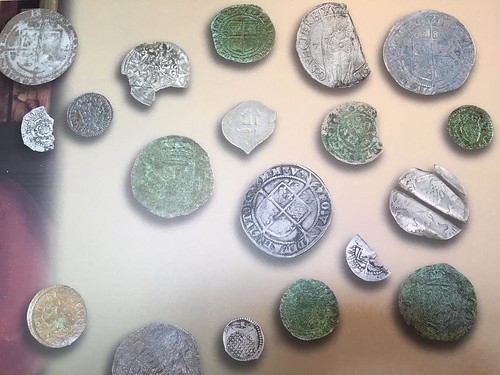
For more information, see:
http://historicjamestowne.org/
CAPE COD METAL DETECTORISTS
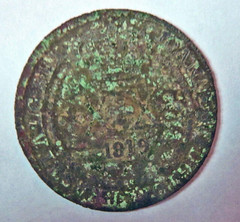 Ever wonder if old relics might be hiding right under your feet? “All the time,” is the response of the group of Yarmouth hobbyists who practice the art of metal detection in a quest to
seek and recover artifacts that have long hidden around Cape Cod and beyond. Typically, detectors are hardy folk who spend many happy hours swinging their wands back and forth across the region’s
soils, beach sands and restless waters. Their goal is to retrieve any coin, ring or other object either lost or discarded by our forebears in the distant past.
Ever wonder if old relics might be hiding right under your feet? “All the time,” is the response of the group of Yarmouth hobbyists who practice the art of metal detection in a quest to
seek and recover artifacts that have long hidden around Cape Cod and beyond. Typically, detectors are hardy folk who spend many happy hours swinging their wands back and forth across the region’s
soils, beach sands and restless waters. Their goal is to retrieve any coin, ring or other object either lost or discarded by our forebears in the distant past.
Sometimes, the thrill of discovery even prompts these adventurers to carry their bulky metal-detection equipment to foreign lands in search of artifacts from long-forgotten eras. A mix of informed guesswork and a healthy dose of imagination makes it possible for detectors to conjure from their finds some interesting tales from our region’s history.
The finds can be as ancient as Roman-era spearheads and silver coins dug up in Spain or as contemporary as a wedding ring lost last summer at the local beach. A few items turn out to be valuable, as with a 5-dollar U.S. gold coin minted in 1834. More often they are everyday items like colonial-era and early U.S. coins, or perhaps Civil War relics dug up at battle sites and cemeteries.
The most mysterious recent find in Yarmouth is a 198-year-old Brazilian copper coin dug up from the ground at Bangs Hallet House. The 20-Reis coin was found by Ken Camilleis, veteran detector and Historical Society of Old Yarmouth member.
Camilleis, the “dirt-digger” who discovered the 20-Ries coin at Bangs Hallet House, notes that it was minted in 1819 in Brazil when it was still part of Portugal’s global empire. Displayed on one side are the Portuguese Crown and XX to show its value (Reis is plural of Real, translating as Royal). The coin’s other side portrays a globe, latitude lines and a coat of arms, with the Latin words Circumit Orbe (Circling the Globe) and Pecunia (Money) scrolled around the edge. Today, this well-worn piece sells online for as little as $3.
How did this coin end up at the historic Yarmouth Port home at 11 Strawberry Road and near the commons off Route 6A? One possibility is that sometime after 1819 it was lost by one of the many customers of a general store run by the Thatcher family between 1802 and 1832 and using the original building at this site.
Alternatively, the coin could have belonged to a resident at the site after 1850, when an expansion of the pre-existing structure created the Bangs Hallet House as it appears today. Good candidates would be two sea captains who occupied the residence after its rebuilding, and who may have acquired the coin while voyaging to far-off lands.
To read the complete article, see:
Detectors excavate secrets of Cape Cod History
(http://dennis.wickedlocal.com/news/20170405/detectors-excavate-secrets-of-cape-cod-history)

VOCABULARY TERM: PLAQUETTE
This vertical plaquette was originally created as a plaque in 1929 by Jonathan M. Swanson which was mounted on the American side of the Ambassador Bridge which connects Detroit and Windsor, Canada. A smaller size – 4 x 2 3/4-inch -- was reduced from that large plaque model. It was struck in 1930 for the bridge’s opening celebration. As the size of plaquettes are greater than 6 inches they are more likely to be cast instead.
Plaquette. An art relief smaller than eight inches (or more precisely, 20 centimeters), which bears a bas-relief design. While plaquettes are usually considered square, rectangular, or nearly so, they appear in a variety of shapes, and can be somewhat more creative with silhouetted, open work, sunken relief, or other sculptural techniques. Plaquettes do not share the restrictions of a round medallic item. In effect, plaquettes are the most artistic – and because they can be easily mounted – the most utilitarian form of medallic art.
Unlike PLAQUES, which are always uniface and larger than eight inches, plaquettes occasionally have a reverse design, particularly those that are diestruck since they are struck with two dies. Otherwise plaquettes have been made by every method that can reproduce a bas-relief design: many forms of casting, electroforming, repoussé, niello, and forging.
But the casting technique, most often used in making early plaquettes, is in continuous use to the present. By making a negative wax impression from a model, pattern, or even an existing plaquette, it could then be cast in the positive. This would usually be cast in bronze. Infrequently, however, plaquettes were made in silver or lead – and much later – in iron, white metals, aluminum, and in the Orient, in pot metal.
After casting, the items were often CHASED, casting imperfections removed and detail sharpened, termed CAST AND CHASED. Most relief items were given a PATINA, or, infrequently they were gilded or silverplated. The makers were the same artists that made medals, undoubtedly because of their experience working in bas-relief and casting in bronze. For collectors and curators it is necessary to determine the STATE of the casting, whether a plaquette is a CONTEMPORY cast, or a second or subsequent generation. Like cast Renaissance medals, a plaquette must be accurately measured to determine this state (see SHRINKAGE).
In modern times the relationship between plaquette and plaque is more than incidental. Plaquettes have, in fact, been reduced from the same model used for a plaque. A DIESHELL is made from the model or pattern which is then pantographically reduced to cut the plaquette die; meanwhile that exact same pattern can then be used to make the plaque the exact size by bronze casting. Often the plaquettes are distributed at the time of the dedication of the plaque after it has been installed.
Mounting plaquettes. Uniface plaquettes were sometimes intended to be mounted on another surface. Because of their size they could be mounted on furniture, desk boxes, book covers, bases of small statues, other objects where an intimate decoration was required. Or, if not intended to be mounted on a flat surface, plaquettes would be provided with a support on the back to be able to stand upright on a table, mantel, altar or shelf. The PAX of the Catholic Church, intended to stand upon the altar, is an example of a plaquette with such a support.
The back of a plaquette was usually left untreated, particularly if intended to be mounted. But just as often it was finished, or a backplate was attached.
History of plaquettes. Early plaquettes were reproduced and this art form spread from their birthplace in Italy – exactly like Renaissance medals – across the Alps to Germany, France, the Low countries and the rest of Europe. Plaquettes may have, indeed, predated the art medal. Some cast pieces in the 12th and 13th century in square or rectangular shape could meet the above definition and be considered plaquettes (particularly those mounted on the bases of statues).
When Pisanello created an entirely new art form in 1439 by casting the first ART MEDAL in lost wax, he also set the stage for the development of the plaquette as a separate object made by the same technique. Thus the plaquette closely paralleled the development of the art medal. Certainly the artistic treatment and strongly religious themes were similar for both classes of art objects.
References: CLASS 01
NC5 {1951} National Gallery of Art (Kress collection).
O11 {1944} Middeldorf.
O12 {1959} Salton. 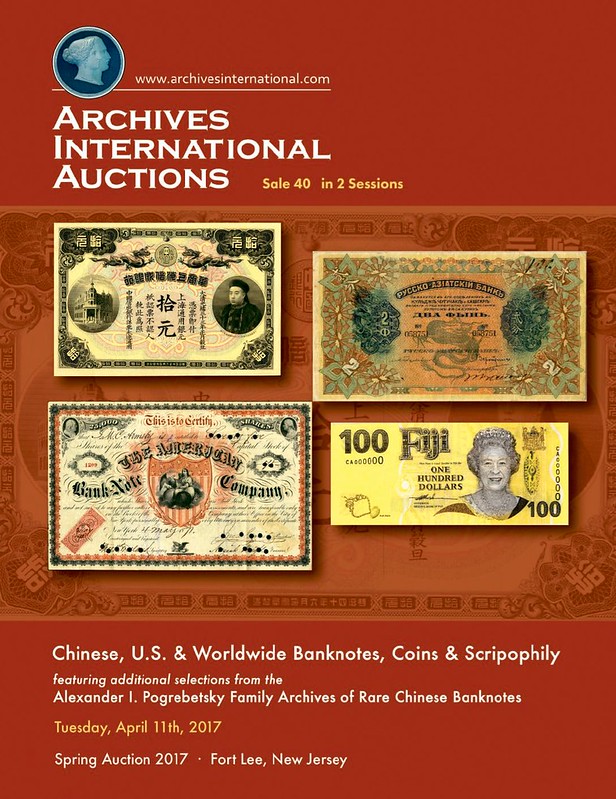
SCOTT STAMP & COIN COMPANY, LTD.
PRELIMINARY REMARKS
There was a time in numismatic history that enjoyed close intimacy of both numismatic fields of stamps and coins. The markets became more disparate since the end of the 1940's and many collectors
became entrenched in one field or the other to the exclusion of the one over the other. To illustrate this point at the 2017 NYINC, the 45th Annual Convention, I was walking about with a copy of
The American Philatelist. Several prominent numismatists looked at it and remarked "I thought stamps died and went out years ago." I was amazed since the stamp market today is bigger
than coins.
In 2004, the global number of philatelic collectors was estimated at 30 million. In 2007, Linn’s Stamp News, conducted a philatelic market survey measuring the size of the American collectible stamp industry finding it at $1.18 billion. Also, in a 2007, Mike Hall of Stanley Gibbons estimated that "About $1 billion of rare stamps trade annually in the $10 billion-a-year stamp market." In 2009, Adrian Roose of Stanley Gibbons estimated the philatelic collectors population at 48 million. In 2014, the U. S. numismatic market was estimated at $5 billion per year, half the philatelic global market estimated ten years previous in 2007. Yet, Coin World reported in 2016 the U. S. numismatic market just topped $4 billion, over $900 million less.
The root of this myopia between both fields of coins and stamps harks back to that period when Lyman Haynes Low resigned as manager of the coin and medal department of Scott Stamp & Coin Co., Ltd in mid to late May 1896, when he completed the sales of the last coin auction for that corporation. In the ensuing fifty years or so the two fields slowly grew apart and remote to the alienation and estrangement of one from the other. A record of this evolving myopia was published in both Scott's Monthly Journal and The Numismatist in the first quarter of 1930. Below is a quote from the April 1930 issue of The Numismatist page 224.
It seems that the philatelists were the first to think and say, "I thought coins died and went out years ago," which I heard echoed by numismatists in January 2017 regarding stamps. However, the coin industry back in 1930 acknowledged that the market wained at one point in the past but recovered and continued to grow steadily strong, healthy and robust. Both stamp and coin markets have experienced continued steady growth since Black Tuesday, October 29, 1929.
One of the goals of NumismaticMall.com is to reintroduce the two mighty arms of the numismatic market to one another, namely stamps and coins. They really are not two unrelated fields at all, but two sectors of one very large market of numismatic collectibles. In order to properly appreciate and comprehend numismatic history it is essential to integrate both in our historical and biographical studies.
Many of the great collectors and dealers of the past were deeply involved in both stamps and coins. One of the first popular numismatic magazines of the past makes this crystal clear even in its title : Mason's Coin and Stamp Collectors Magazine. It is an anachronistic perspective that expresses the notion that preeminent dealers like S. H. & H. Chapman only sold stamps when the coin industry was slow. The Chapman Brothers were both stamp and coin dealers who enjoyed both fields as did others besides W. E. Woodward, Ebenezer Locke Mason, Jr., John Walter Scott, John W. Haseltine, David Proskey, Ed Frossard, William P. Brown, Harlan Page Smith, Robert W. Mercer, Henry Ahlborn, John Hubbard, W. E. Skinner, J. G. Bingham, Lewis T. Brodstone, Hiram E. Deats, D. T. Eaton, Frank E. Ellis, Burdette G. Johnson, John W. Kline, A. C. Roessler, to mention only just a few of the better known dealers, not including dozens of those lesser known. Many of the great collectors of the past also amassed famous collections of both stamps and coins.
The biographical sketch below is of a corporate entity known to both fields of stamps and coins, i.e., Scott Stamp & Coins Company, Ltd. which in the heyday of numismatic growth and development was the hub of unity among collectors and dealers in both sectors of the numismatic market. These two fields have become estranged since the late 1940's and leading exponents today have a muddled vision of this now defunct corporation. Surprisingly, most people, including well informed numismatists, excepting Lorraine S. Durst, have a blurred vision of just what exactly Scott Stamp & Coin Company, Ltd. was.
Typically most numismatic and philatelic researchers conflate the Scott companies by mixing them up and lumping them all together as one continuous blob of corporate catalogues and auctions. In numismatic literature Lorraine S. Durst got it right keeping them separate. In philatelic literature the editors of the Crawford Catalogue, Edward D. Bacon and D. R. Beech, got it right also by keeping them separate. It is understandable how even the best researcher can get mixed up and confused.
Scott Stamp & Coin Company, Ltd.
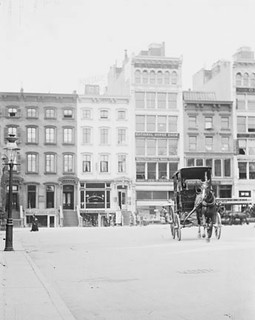 Scott Stamp & Coin Company, Ltd., was the second of three separate companies of the Scott name though not affiliated with two others formed by John W. Scott. The original company was formed
in 1867 as John W. Scott & Co., and also in 1875 as Scott & Co. For a good look at that company see the biographical sketch of John W. Scott on this website.
Scott Stamp & Coin Company, Ltd., was the second of three separate companies of the Scott name though not affiliated with two others formed by John W. Scott. The original company was formed
in 1867 as John W. Scott & Co., and also in 1875 as Scott & Co. For a good look at that company see the biographical sketch of John W. Scott on this website.
Below is the story of Scott Stamp & Coin Co., Ltd. which resulted from John W. Scott selling all of his company stock and the syndicate that bought it wasted no time renaming it Scott Stamp & Coin Company, Ltd. The first auction catalogue bearing the new name was sale No. 70 issued February 15, 1886. The third Scott company was formed after John W. Scott left his company (now renamed Scott Stamp & Coin Company, Ltd.), in which he returned to his original name John W. Scott & Co., Ltd., and for which he was sued by Scott Stamp & Coin Company, Ltd., claiming it to be an infringement. John W. Scott won the lawsuit and was allowed to continue in business using his own personal name.
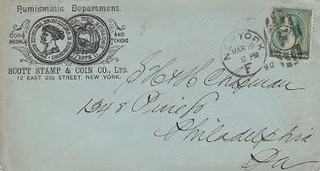 On December 10, 1885, in order to pursue other investments, John Walter Scott (1845-1919), sold his business to a syndicate stock company owned by Henry Lincoln Calman (1863-1935) and his
older brother Gustav "Gus" Bernhard Calman (1860-1898), and their business partner Henry Collin. They renamed the firm Scott Stamp & Coin Company, Ltd. The Calman brothers were stamp
dealers and hired Lyman Haynes Low as the manager of the Numismatic Department, also called the Coin and Medal Department.
On December 10, 1885, in order to pursue other investments, John Walter Scott (1845-1919), sold his business to a syndicate stock company owned by Henry Lincoln Calman (1863-1935) and his
older brother Gustav "Gus" Bernhard Calman (1860-1898), and their business partner Henry Collin. They renamed the firm Scott Stamp & Coin Company, Ltd. The Calman brothers were stamp
dealers and hired Lyman Haynes Low as the manager of the Numismatic Department, also called the Coin and Medal Department.
See John's web site for more; it's a long and complicated story. The early history of coin and stamp collecting in the U.S. is quite intertwined and the early literature is difficult to sort into today's seperate categories - most dealers and publishers of the day handled both coins and stamps. Are the two hobbies lost lost brothers? -Editor
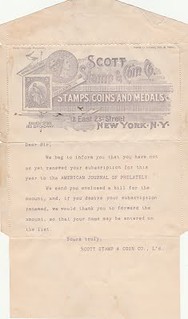
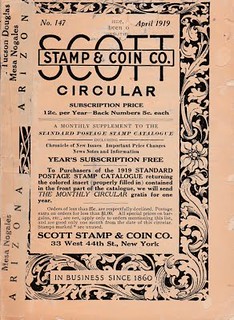
To read the complete article, see:
SCOTT STAMP & COIN COMPANY, LTD.
(https://sites.google.com/a/numismaticmall.com/www/numismaticmall-com/scott-stamp-coin-company-ltd)
A BROAD DEFINITION OF NUMISMATICS
Numismatics is the study of any object serving as a customary or legal means of conveyance for all forms of payment, award or reward having measurable monetary value, or an engraving, scrip, or advertisement imitating that normative means, or any small portable metallic or other portable durable material such as paper serving as a vehicle conveying either a legal register for economic exchange purposes or taxation, or else having a socially esteemed, venerated or coveted value of award resembling a form customary for payment, award or reward.
The word numismatics is derived from Greek and Latin with the Greek having the notion of currency from the Greek words νόμος "nomos", a habitual practice of social custom or convention, law or ordinance, and the Greek word νόμισμα "nomisma", anything sanctioned by current or established usage or custom, and the Latin words nummus and nummulus meaning money.
As you can see from the above definition of numismatics the entire field of philatelics is also necessarily included. Traditionally since the 1940's, numismatics and philatelics have been largely considered as belonging to two separate and distinct fields of subject matter and study. However, upon careful reading and understanding the above definition one can easily see that they are neither separate nor distinct in their subject fields and area of study. Stamps like coins are a currency produced by stamping or impressing a die.
Coin and paper money specialists who study dies and their varieties will thoroughly enjoy the many challenges they face in the philatelic world which is much more demanding as is it is clearly plain to see due to the three to four major dies involved on dated and cancelled envelopes called covers in the stamp collecting world, bearing postage stamps and the numerous other ancillary slugs used for customizing them for the days work.
Comparatively there are far more dies and stampings on a single cover than on any coin, medal or paper currency making stamp collecting far more varied and fascinating with breadth and depth unparalleled in any other branch in numismatics as a whole.
In the 19th century and in the first few decades of the 20th century many of the great collectors and hobbyists collected both stamps and coins and could see the clear relationship between them and paper money, bank-checks, money orders, and notaphily, i.e., stock certificates or scrip. Over the past fifty to sixty years, i.e., since the late 1940's or so the two classes of collecting have been alienated from one another and many collectors today see no real relationship between them and even rival them disdaining the other. It is hoped that the contents of this website and the various databases and articles will demonstrate the unity between both fields of study and show that philatelics is not only a branch of numismatics but one of its finest.
We've certainly seen increasing specialization over the years, with even what we today see as the numismatic side devolving into coin, token, medal and paper money specialties and sub-specialties.
As a collector and researcher of Encased Postage Stamps and Postage Stamp Envelopes I certainly crossed both fields, and was quite aware of publications such as The Essay-Proof Journal which had quite an overlap between the worlds of stamp and paper money collecting. What do readers think? Have the coin and stamp fields diverged so far that we can never again sit at the same table? -Editor
To read the complete article, see:
"Towards an Operative Definition of Numismatics"
(https://sites.google.com/a/numismaticmall.com/www/numismatics-defined)

DENVER MINT SUPERINTENDENT NORA WALSH HUSSEY
 In 1981, Nora Walsh Hussey was appointed by President Ronald Reagan to be superintendent of the Denver Mint.
In 1981, Nora Walsh Hussey was appointed by President Ronald Reagan to be superintendent of the Denver Mint.
Hussey, who lived in Sturgis at the time, appeared in front of the Senate Banking, Housing, and Urban Affairs Committee in Washington to answer questions.
“They weren’t difficult,” she said. “It was short and sweet.”
Hussey was unanimously confirmed and moved to Denver, becoming the first non-Coloradan to be superintendent of the Denver Mint, which began striking coins in 1906.
Hussey, who now lives in Spearfish, will turn 102 today. She recalled her days at the mint and earlier involvement in local politics in a recent interview.
During Hussey’s seven years at the mint, “We made billions of pennies. They were by far ordered the most,” she said.
In early 1982, all mint facilities stopped producing the mostly copper-alloy penny and moved to a copper-plated zinc. “We had the last backlog of copper in the country, so it wasn’t until fall that we changed the penny like they had already done at the rest of the facilities,” she said.
Using a patented electroplating process, the new metal-composition strips were struck by dies sent from Philadelphia. Over 6 billion pennies were minted in 1982 at the Denver Mint.
Hussey said that the new zinc-covered pennies were not that much different side by side, but she felt that the older, more copper coins, were “just prettier when new.”
The modified dies for the new metal mix pennies were not sent right away, so the old dies with larger date numbers were used in production for a short time. Those particular pennies and other die variations from 1982 are considered quite desirable to some collectors today.
Hussey supervised the entire Denver Mint operation until 1987. Since then, her public service has been recognized by Gov. Dennis Daugaard, who proclaimed March 17, 2012, Nora Walsh Hussey Day, commending her “for her dedicated and outstanding service to this state and country.”
Hussey said she is thankful for her the time she spent at the mint. “I made many friends there,” she said. “It was a fun place to work that I enjoyed immensely.”
To read the complete article, see:
Spearfish woman made her mark at Denver Mint
(http://rapidcityjournal.com/lifestyles/spearfish-woman-made-her-mark-at-denver-mint/article_bcf8be23-5561-516d-bdff-99fdb288a1fa.html)
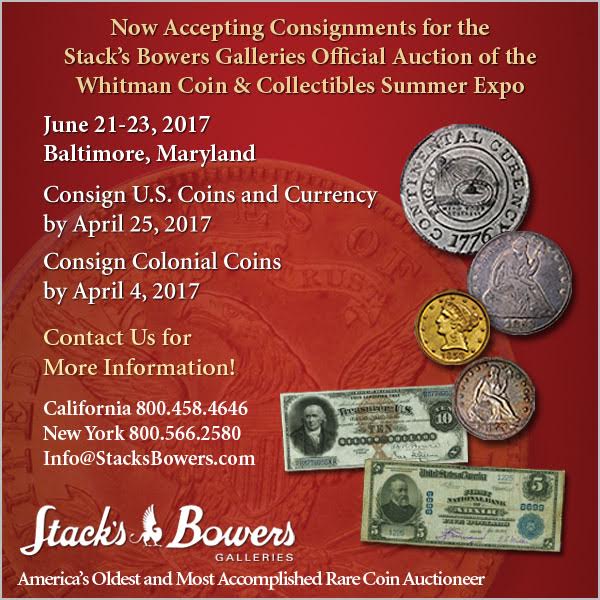
THE INVENTION OF THOMAS WILFRED
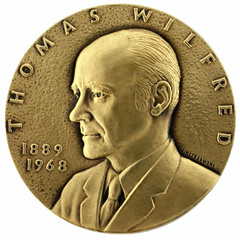
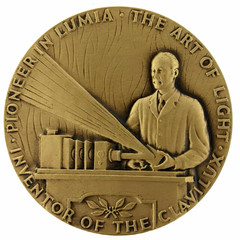
I enjoyed the brief review of the Thomas Wilfred Clavilux medal in the last issue. One thing missing was any hint of the intended use of this marvelous machine. I researched it for "A Century of Civility, Centennial History of the New York Numismatic Club," published 2008. I included the Clavilux medal with the Presidential Medal of the second Tom Wilfred, a great Past President of NYNC.
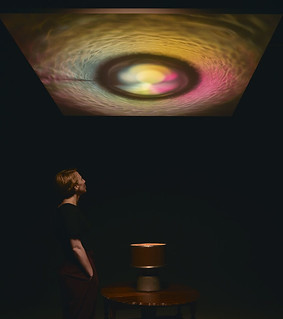 No info was provided in the recent coverage as to the use of this "dancing light" invention which was to accompany lectures of the Theosophist Society which brought together
occultist believers and followers of Madame Helena Petrovna Blavatski, famous Russian-born mystic of the late 19th century. One of the more prominent and fashionable late Victorian occultists, she
claimed extensive mystic powers and first-hand insights into the mystic spirit world and her followers remain active in Europe, the British Isles, India and America.
No info was provided in the recent coverage as to the use of this "dancing light" invention which was to accompany lectures of the Theosophist Society which brought together
occultist believers and followers of Madame Helena Petrovna Blavatski, famous Russian-born mystic of the late 19th century. One of the more prominent and fashionable late Victorian occultists, she
claimed extensive mystic powers and first-hand insights into the mystic spirit world and her followers remain active in Europe, the British Isles, India and America.
We might add that the first Tom Wilfred was the last president of the short-lived Collectors of Art Medals (CAM) back in 1972. CAM was an ambitious attempt to boost appreciation and collecting of world and U.S. medals. It was much given to vain-glorious boasting about the size its membership was going to attain, outstripping the ANA in a few years, etc. Lacking coherent, active leadership, CAM emptied its treasury preparing the first issue of a magazine that was going to be a wonder of the world but which was never actually published.
When I founded Medal Collectors of America (MCA) in 1998, we avoided boasting in favor of solid achievement, registering successes that were possible with resources at hand.
Let's hear it for the Clavilux!
David Thomason Alexander
Founder, Medal Collectors of America
To watch a YouTube video, see:
1930 CLAVILUX made by Thomas Wilfred, in operation (www.youtube.com/watch?v=icGdtUQy5qQ)
For more information on the Yale exhibition, see:
Lumia: Thomas Wilfred and the Art of Light
(http://artgallery.yale.edu/exhibitions/exhibition/lumia-thomas-wilfred-and-art-light)
To read the earlier E-Sylum article, see:
DICK JOHNSON VISITS THE YALE ART MUSEUM (www.coinbooks.org/v20/esylum_v20n14a16.html)
MEET THE MUDLARKS
Joseph Fox photographed the mudlarkers who comb the shore of London's River Thames. Originally a term for the city's poor who scraped a meagre living by scavenging in the river's mud, it has been adopted by a new breed of treasure hunters, often armed with metal detectors.
These men and women show off their favourite finds, and discuss the joys of mudlarking.
Dave Hiddleston, Limehouse
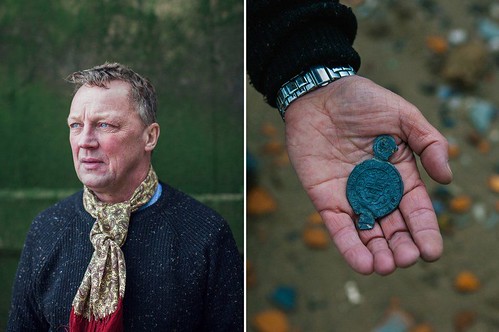
Long fascinated by history and collecting, Dave first discovered mudlarking while he was working on Cannon Street and saw people on the foreshore in wellington boots.
His favourite find is an English community cloth seal, which he believes was used to stamp cloth bags coming through London in about 1618. It was inside a lump of burnt cinder.
Sara Cannizzaro, Vauxhall
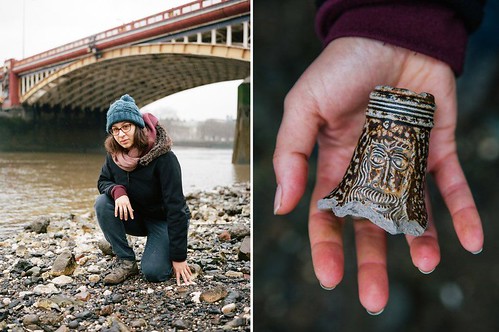
It's the unexpectedness of mudlarking that drew Sara to it, in contrast to the routine of London life.
"I feel the excitement when I'm walking along the bank," she said. "It's a way of making order out of chaos."
Sara has managed to find a piece of Bartmann jug, which - from the splashes of cobalt blue glaze - she has dated to 1600-20, made in Frechen.
She said: "The face that was impressed on the neck of these jugs is a prized find from all mudlarkers - everyone wants to find one!"
Flickr follower Stuart Williams of Ireland writes:
I used to do that when living in London during the late 80s and early 90s. Me and the children would drive in on Sundays to catch the ebbing tide and walk from Trigg Stairs along the foreshore picking up anything of interest we found. Free parking on Sundays and no driving restrictions then. Load of interesting potshards which are great for research and by researching to identify them, we learned a lot about pottery. There were plenty of 17th and 18th century clay pipe heads and stems. I once found a portion of the bottle neck having half a face (Bartmann jugs). Antique nails but alas, we never did find any coins or tokens on those visits.
It was a great way to spend a Sunday morning, very fulfilling and educational. Sadly, it's been commercialised and even to walk the foreshore now, one needs a permit and I understand they cost a lot of money!
Edward Sandling, Vauxhall
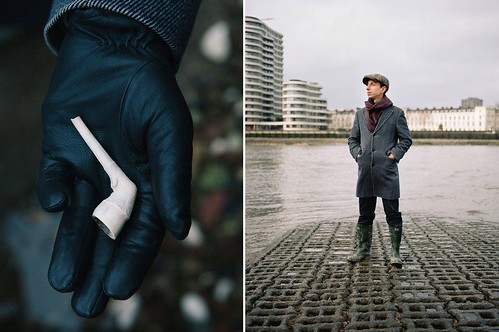
Ted discovered mudlarking by chance. "I was walking along South Bank," he said, "and I just hopped over a gate and came down to the foreshore. You get a sense of quietude and the perspectives on the city are so different, just by that small change of level."
He then noticed the objects at his feet, such as this pipe stem shaped like a horse's hoof. He said: "I have finds that are older and perhaps more beautiful, but this is the one that set it all off.
"It's absolutely beautiful. To hold it and know that someone else was smoking it 150 to 200 years ago is amazing."
Stuart Williams adds:
Those horse hoof pipes are surprisingly common. They date from the late 19th to the early 20th centuries. I used to find a lot of clay pipe heads and fragments with most of them being 17th and 18th centuries. All were plain with no interesting designs, alas! Sometimes a pipe head dating to the 16th century would also be found.
To read the complete article, see:
Hunting for treasure at low tide (www.bbc.com/news/in-pictures-39365669)

A CHOPMARKED COIN PROGRESSION SET
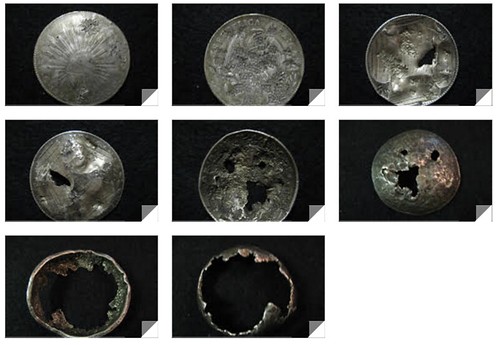
Larry Korchnak writes:
I noticed the article on the chopmarked trade dollars in The E-Sylum. I was inspired to dig up a "progression set" of chopmarked Mexico 8 reales that I purchased from John Cobb some years ago at an ANA show. Four coins are photographed... obverse and reverse in sequence yielding eight images.
To read the complete article, see:
STACKS BOWERS OFFERS CHOPMARKED TRADE DOLLARS (www.coinbooks.org/v20/esylum_v20n13a31.html)
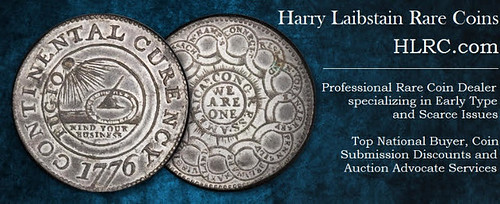
HERITAGE OFFERS ERIC P. NEWMAN INTERNET 3 SALE
Eric P. Newman Currency Rarities on Offer at Heritage Auctions
Items being sold are from the extensive collection of Eric P. Newman’s Numismatic Education Society
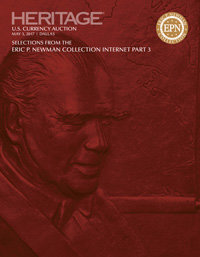 A 1775 Massachusetts Bay Colony 5 Pounds 4 Shillings Bond (est. $5,000-$10,000) leads nearly 1,500 pieces from the Eric P. Newman Collection Internet Part 3, which will be auctioned at no
reserve in Heritage Auctions’ Internet Currency Auction, Wednesday, May 3. Newman, the premier American numismatic researcher and writer, curated a collection of coins and currency unmatched in
quality or depth.
A 1775 Massachusetts Bay Colony 5 Pounds 4 Shillings Bond (est. $5,000-$10,000) leads nearly 1,500 pieces from the Eric P. Newman Collection Internet Part 3, which will be auctioned at no
reserve in Heritage Auctions’ Internet Currency Auction, Wednesday, May 3. Newman, the premier American numismatic researcher and writer, curated a collection of coins and currency unmatched in
quality or depth.
The 1775 Massachusetts Bay Colony 5 Pounds 4 Shillings Bond loans were used to finance the Continental Army in the first years of the American Revolution and printed from a copper plate engraved by Paul Revere. Sharp details indicate this example was among the first printings. PCGS grades the piece Very Fine 20.
Uncut items are a popular subset of currency collecting, and the Newman Collection contains several rarities. A Perforated Block of Eight First Issue Fr.1229 5-Cent Notes (est. $3,000-$6,000) will be offered to collectors for the first time. No-monogram 5-cent notes are exceptionally rare, and Heritage has offered a block of eight just once before. The notes are graded PCGS Choice 58PPQ and exhibit only minuscule handling wear. A Confederate Sheet of 10 T20 $20 Notes (est. $2,500-$5,000) is sure to attract collectors as well. PCGS grades the sheet Extremely Fine 45, superior to a majority of similar Confederate sheets sold recently.
Heritage Auctions is also offering a rarity from one of the most popular territorial series. An 1830 Territory of Florida $1 Note (est. $2,500-$5,000) should attract collectors with its low serial number and high grade. At PCGS Very Fine 35, it is among the finest of its type. Less than 40 Florida Territory $1 notes are known to survive. Another $1 note is highlighted in the sale, an 1850 $1 Note, Issued by the Phenix Bank in New York (est. $1,000-$20,000), will be on offer. The ornate note shows sharp detail and is graded Very Fine 35 by PCGS.
Rounding out the featured lots is a somewhat mysterious note. An Undated Steamer J.A. Cotten 25 Cents Note (est. $1,000-$2,000) is worthy of exhaustive research. In addition to “Steamer J.A. COTTEN” text and the denomination, the small note contains a pair of steamboat vignettes and the obligation “Due by Narcisse Paris, Redeemable in Three Dollars.” Logic suggests the note is in relation to the Confederate steamer J.A. Cotton, which was sunk by Union forces on April 14, 1863. However, its association with the ship is currently unconfirmed.
Online proxy bidding opens on the auction’s nearly 1,500 lots April 5 at HA.com/241626, with the auction starting at 10 a.m. Central Time May 3 on HA.com.
To read the complete press release, see:
Eric P. Newman Currency Rarities on Offer at
Heritage Auctions (https://www.ha.com/heritage-auctions-press-releases-and-news/eric-p.-newman-currency-rarities-on-offer-at-heritage-auctions.s?releaseId=3157)
SELECTIONS FROM THE NEWMAN INTERNET 3 SALE
Selections from Newman Collection Internet Part 3
Nearly 1,500 unreserved currency lots from the Eric P. Newman Collection Internet Part 3 are available for bidding at Heritage Auctions. Colonial, Continental, Obsolete, Confederate, and Fractional notes are included this latest Newman Internet auction. Some of the many highlights are listed below with links to the images and full descriptions:
1775 Massachusetts Bay Colony 5 Pounds 4 Shillings Bond
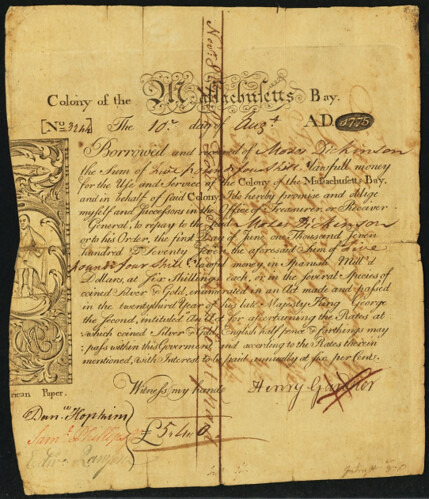
The 1775 Massachusetts Bay Colony 5 Pounds 4 Shillings Bond loans helped finance the infancy of the American Revolution. Known as “King Philip” bonds, they were printed from a Revere-engraved copper plate. This iconic rarity is a sharp and vibrant early plate state example.
To read the complete lot description, see:
Colony
of the Massachusetts Bay - Provincial Act of May 3, 1775 6% Loan due June 1, 1777. 5 Pounds 4 Shillings Augt. 10, 1775
(https://currency.ha.com/itm/colonial-notes/massachusetts/colony-of-the-massachusetts-bay-provincial-act-of-may-3-1775-6-loan-due-june-1-1777-5-pounds-4-shillings-augt-10-1775/a/241626-89364.s)
Perforated Block of Eight First Issue Fr.1229 5-Cent Notes
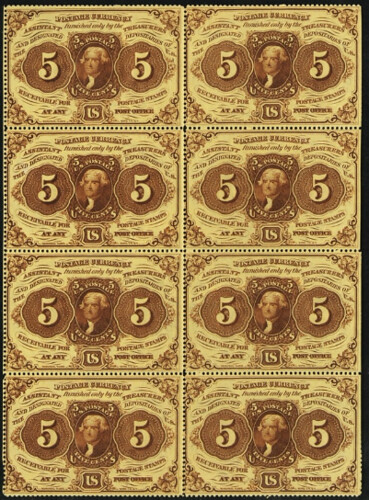
From his Fractional currency holdings, Newman’s exceedingly rare Perforated Block of Eight First Issue Fr.1229 5-Cent Notes is making its first auction appearance. Uncut items are always sought after by collectors, and this is only the second such no- monogram 5-cent block of eight offered by Heritage.
To read the complete lot description, see:
Fr. 1229 5¢ First Issue Block of Eight
(https://currency.ha.com/itm/fractional-currency/first-issue/fr-1229-5-first-issue-block-of-eight-pcgs-choice-about-new-58ppq/a/241626-89395.s)
Confederate Sheet of 10 T20 $20 Notes
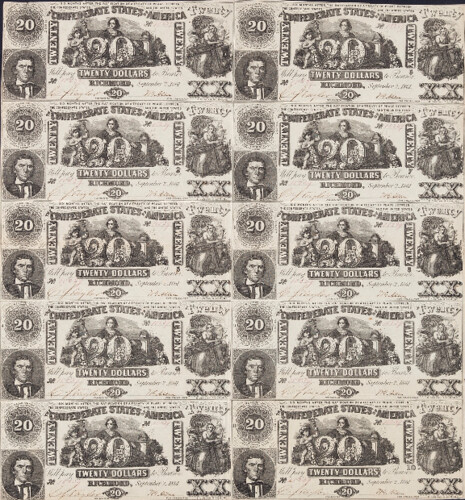
Another uncut rarity, a Confederate Sheet of 10 T20 $20 Notes provides a significant opportunity for collectors. This bold example is superior to a majority of similar Confederate sheets sold recently.
To read the complete lot description, see:
Confederate
States of America - Uncut Sheet of Ten T20 $20 September 2, 1861 PF-8 Cr. 142 Notes.
(https://currency.ha.com/itm/confederate-notes/1861-issues/confederate-states-of-america-uncut-sheet-of-ten-t20-20-september-2-1861-pf-8-cr-142-notes-pcgs-extremely-fine-45/a/241626-89500.s)
Undated Steamer J.A. Cotten 25 Cents Note
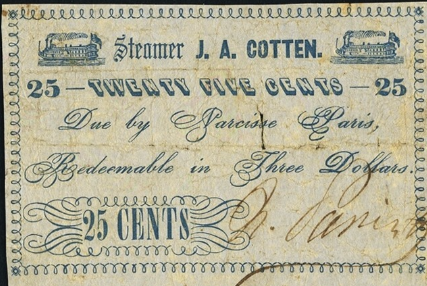
And lastly is the enigmatic Undated Steamer J.A. Cotten 25 Cents Note, worthy of exhaustive research because of its possible connection to the Confederate steamer J.A. Cotton. Accounts show the partially ironclad steamer being sunk by Union forces in 1863 at Bayou Teche. If confirmed as a Confederate navy-related scrip issue, this note’s historical importance cannot be overstated.
To read the complete lot description, see:
[Unknown,
LA] - Due by Narcisse Paris - Steamer J. A. Cotten 25 Cents Undated (ca.1862). PCGS Very Fine 20 Apparent. . ...
(https://currency.ha.com/itm/obsoletes-by-state/louisiana/-unknown-la-due-by-narcisse-paris-steamer-j-a-cotten-25-cents-undated-ca1862-pcgs-very-fine-20-apparent/a/241626-89920.s)
To view the complete sale, see:
Selections from the Eric P. Newman Collection Part 3 Wednesday Internet Currency Auction #241626
(https://currency.ha.com/c/auction-home.zx?saleNo=241626)

NUMISMATIC NUGGETS: APRIL 9, 2017
Silver Denarius of Sextus Pompey
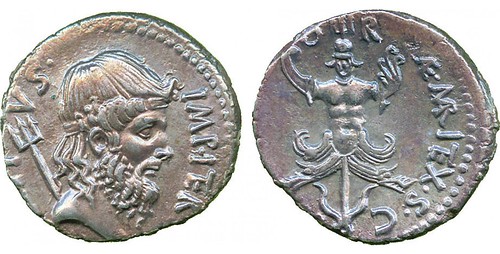
Sextus Pompey, Silver Denarius, minted in Sicily, struck 37-36 B.C. [MAG P]IVS IMP ITER, diademed and bearded head of Neptune facing right, a trident over his shoulder, rev [PRAEF CLAS ET] ORAE MARIT EX S C, naval trophy set on an anchor and supported by a trident, heads of Scylla and Charybdis at base, 3.50g., 12h (Cr 511/2b; Sydenham 1347; RBW 1784). Well-struck and toned, a little short of flan, extremely fine, a very good example.
To read the complete lot description, see:
Sextus Pompey, Silver Denarius, Minted In Sicily, Struck 37-36 B.C.
(http://www.baldwin.co.uk/sextus-pompey-silver-denarius-minted-in-sicily-struck-37-36-b-c-mag-p-ivs-imp-iter-diademed-and-bearded-head-of-neptune-facing-right-a-trident-over-his-shoulder-rev-praef-clas-et-orae-marit-ex-s-c-naval-trophy-set-on-an-anchor-and-supported.html)
1640 French Colonial Fleur de lis Counterstamp
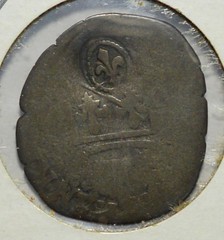
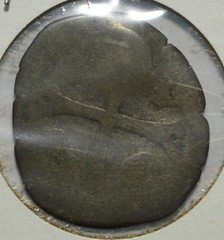
1640 French Colonial Fleur de lis Counter-Stamped on Douzain of Henry IV for Use in Canada under France. Struck under Louis XIII.
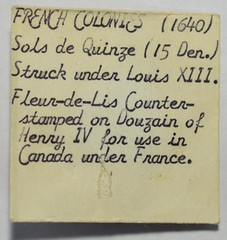 What I found interesting about this lot was the envelope. Does anyone recognize the typeface or description style? Does it belong to a known collector or dealer? -Editor
What I found interesting about this lot was the envelope. Does anyone recognize the typeface or description style? Does it belong to a known collector or dealer? -EditorTo read the complete lot description, see:
Lot 50: 1640 French Colonial Fleur de lis Counter-Stamped
(www.invaluable.com/auction-lot/1640-french-colonial-fleur-de-lis-counter-stamped-D124DC48D4)
1828 Convict Love Token
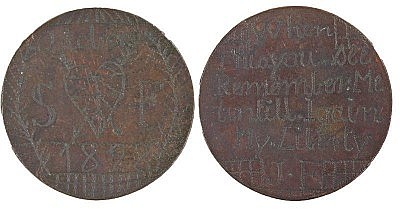
Rare circa 1828 Prisoners engraved "Love Token" coin, the coin engraved to one side "When this finds you bee, Remember me until I gain my Liberty, J.F. the opposing side "October 23 1828, a S F either side of a heart, 35mm diameter - Stock
To read the complete lot description, see:
Lot 255: Rare circa 1828 Prisoners engraved "Love Token" coin, the coin engraved to one side "When this finds you bee,
Remember me until I gain my Liberty, J.F. the opposing side "October 23 1828, a S F either side of a heart, 35mm diameter - Stock (www.invaluable.com/auction-lot/-1-c-52B4074910)
To read earlier E-Sylum articles, see:
CONVICT LOVE TOKENS? (www.coinbooks.org/esylum_v06n33a10.html)
CONVICT LOVE TOKENS (www.coinbooks.org/esylum_v06n34a08.html)
CONVICT LOVE TOKEN BOOK AVAILABLE (www.coinbooks.org/esylum_v06n37a04.html)
1892 Columbian Exposition Medallion
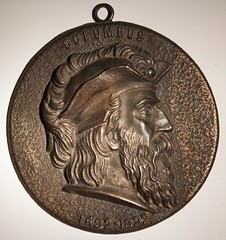
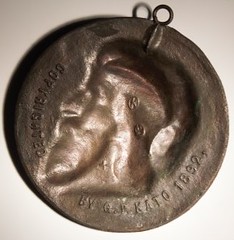
Rare Kato medal of Christopher Columbus to commemorate the Columbian Exhibition in 1892. Measures approximately 5 inches in diameter.
To read the complete lot description, see:
Lot 520: Rare Columbian Exposition 1892 medal by Kato (www.invaluable.com/auction-lot/-1-c-14C4982ADB)
1890s Labor Exchange Check
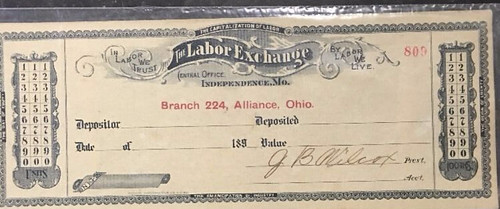

To read the complete lot description, see:
RARE MINT 1890's Labor Exchange Punch Box Note Check Early Labor Signed Unused (www.ebay.com/itm/262924029817)
1912 International Regatta Medal
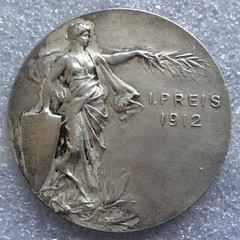
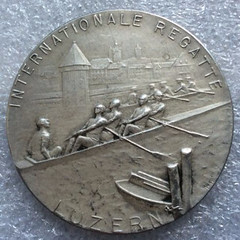
Material: Silver
Geographical Origin: Switzerland
Switzerland. Silver medal 1912 (Huguenin) I Preis Internationale régatte Luzern. 40 mm, 23.45 gr.
To read the complete lot description, see:
90. Switzerland - silver medal 1912 (Huguenin) I Preis
Internationale régatte Luzern (https://auction.catawiki.com/kavels/10990395-switzerland-silver-medal-1912-huguenin-i-preis-internationale-r-gatte-luzern)
Eight Test Bank Notes
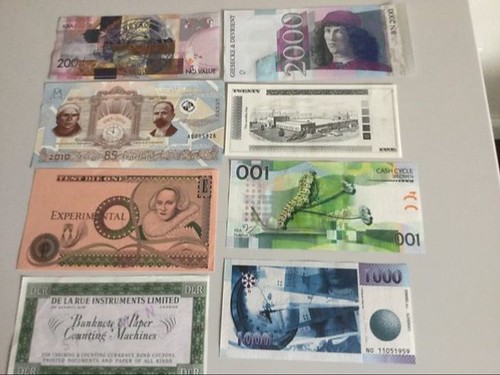
8 TEST NOTES
DE LA RUE INSTRUMENT LONDON AU
KBA JULES VERNE 2004 SWITZERLAND
BANCO DE MÉXICO 2010... 85 ANIVERSARIO UNC
KBA 001CASH CYCLE SWITZERLAND UNC
BANK OF ENGLAND EXPERIMENTAL TEST THE ONE UNC
SLOVAKIA 1000 CROWNS DIMANO
GIESECKE & DEVRIENT BOTICELLI 2000 BLUE HAIR UNC
TWENTY DOLLARS BANK OF CANADA UNC
INTAGLIO PRINTING AND WATERMARKS AND MANY SECURITY FEATURES
To read the complete lot description, see:
99. TEST NOTES - 8 pcs - Bank of Canada,
G&D, Slovakia, Bank of England, KBA Switzerland, Banco de Mexico, De La Rue.
(https://auction.catawiki.com/kavels/11081777-test-notes-8-pcs-bank-of-canada-g-d-slovakia-bank-of-england-kba-switzerland-banco-de-mexico-de-la-rue)
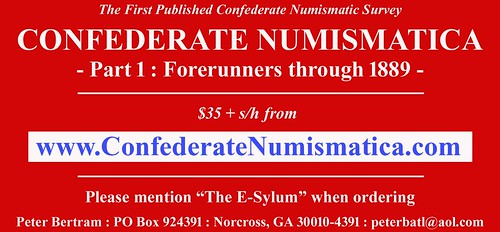
1981 ALLSTATE 50TH ANNIVERSARY MEDAL
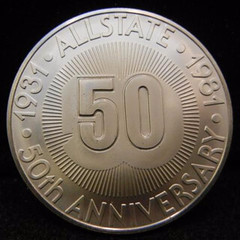
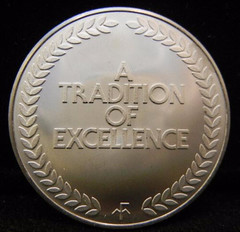
To read the complete lot description, see:
Lot 45S: 1981 Allstate 50th Anniversary Token (www.invaluable.com/auction-lot/-1-c-E294E2089A)
1981 Allstate 50th Anniversary Key Fob
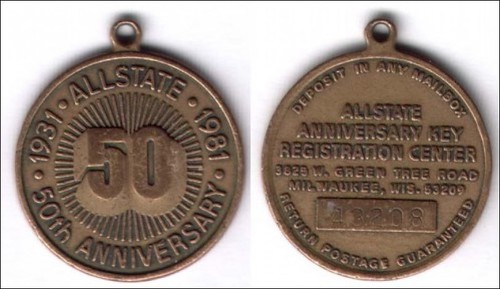
To read the complete lot description, see:
32mm round brass key fob: 1931-1981 Allstate 50th Anniversary//deposit in any mailbox, Allstate, Milwaukee, Wis.
(http://auction.tokencatalog.com/auction_print.php?auction_id=142959)
THE BOOK BAZARRE
THE COMPUGRADE MEDAL
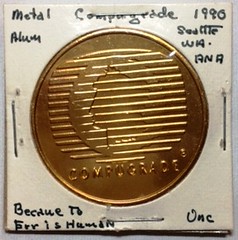
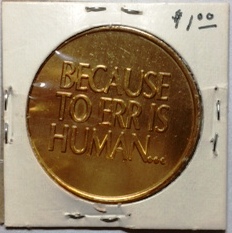
Not Exactly Samples – Compugrade Medal
Compugrade is one of the scarcest and most desirable samples, with none selling on eBay in the last three and a half years. Even their production slabs are rarely seen.
This anodized aluminum medal is also an uncommon relic of Compugrade’s brief existence. According to the 2x2 holder, this 40mm medal came from the 1990 ANA convention in Seattle. I paid more than the $1 on the holder, but not the $40 - $50 they typically bring on eBay.
Compugrade attempted to grade coins using computerized equipment instead of expert graders. PCGS attempted a similar task in 1989, also unsuccessfully. In a panel discussion with PCGS founders moderated by Steve Roach, David Hall mentioned that, many years later, he asked the same computer expert who worked on the project whether it was now possible to try again, now that we have better computers. With better computers, the expert said, the computer would just make the same mistakes faster. There is nothing like the human eye.
 I'm old enough to know better than to ever say never. Perhaps someday computers will indeed at least be a passable grading assistant. But it would require a large investment of money,
time and expertise, and a willingness to look past the failures of the past. That's a tall order, and I think third-party grading jobs are still safe from our robot overlords.
I'm old enough to know better than to ever say never. Perhaps someday computers will indeed at least be a passable grading assistant. But it would require a large investment of money,
time and expertise, and a willingness to look past the failures of the past. That's a tall order, and I think third-party grading jobs are still safe from our robot overlords.
Were any of our readers involved in Compugrade, or attended its publicity events? Who were the skeptics? Who drank the Kool-Aid? Did it just gradually fade away or have a public flameout? First-hand stories are welcome.
Thanks to David for permission to republish this; he also provided the CompuGrade sample slab image shown here. -Editor
To view the PCGS Founders video, see:
PCGS Founders' Roundtable (Full Video) (https://www.youtube.com/watch?v=YCYIjDQEtR8&t=1905s)
For more information on the Sample Slab Update, see:
Sample Slab Book.com (http://www.sampleslabbook.com/)
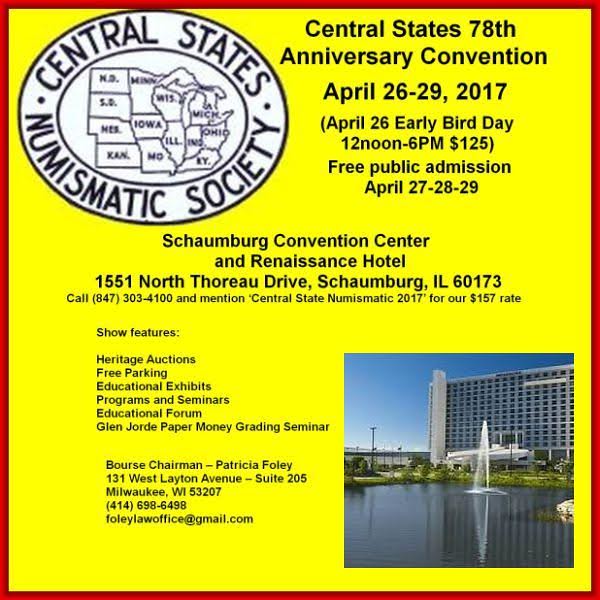
PERSIA’S ACHAEMENIDAE GOLD DARIC
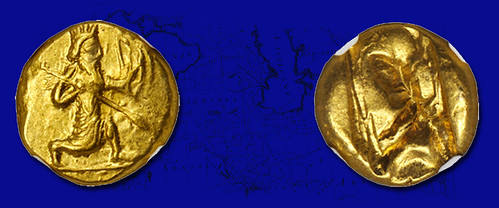
The mighty Persian Empire, fathered by Cyrus the Great, adversary of the Greek city-states, and shattered by Alexander the Great, provides an exceptional gold Daric for our upcoming May Collectors Choice Online auction. The royal dynasty that ruled the empire was known as the Achaemenids, derived from their legendary founder Achaemenes. This vast empire would control portions of Thrace and Macedonia to the Indus Valley, and parts of Egypt, Central Asia and the Arabian Peninsula.
Some notable achievements of the empire include a postal system, roads, and the use of an official language. Despite these advancements, the central government eventually lost control of the local governments, who openly rebelled on numerous occasions. The empire was in a disorganized state by the time Alexander the Great of Macedon invaded. Alexander attempted to integrate himself as an Achaemenidae ruler, but died just a few years later. Seleucus inherited the Asian portions of Alexander’s realm, with the Seleucid Empire continuing the Achaemenidae Empire.
Coinage created in the Persian Empire was almost exclusively used for trade with the Greeks, and not for inter-imperial trade. The Persians maintained a system of direct exchange or contribution of services and natural goods and coins as a bartering tool were scarcely needed. Most of the Persian Empire’s coinage was produced at Sardes, at the far western edge of the empire, as it was in close proximity to the Greeks and their trade. The gold pieces produced at Sardes for the Persians became known as Darics after their “inventor” Dareios. These pieces would be used to pay for Greek mercenaries. The gold Darics depicting the “Great King” of Persia would become nearly as famous as the well known Athenian Tetradrachms throughout the Mediterranean world.
The coin’s design features the Persian Great King in a kneeling-running stance facing right. The bearded and mural crowned king holds in his right hand a spear with the tip pointed down and a bow in his left hand. The reverse is an incuse punch design which is iconic for the type. The coin is well centered, with the entire obverse design present. This coin was struck sometime during the reigns of Xerxes II, Sogdianus, Darius II, or Artaxerxes II (ca. 420 – 375 B.C.).
To read the complete article, see:
Persia’s Achaemenidae Gold Daric (www.stacksbowers.com/News/Pages/Blogs.aspx?ArticleID=2492)
DESIGNER GAULTIER CREATES FRENCH COINS
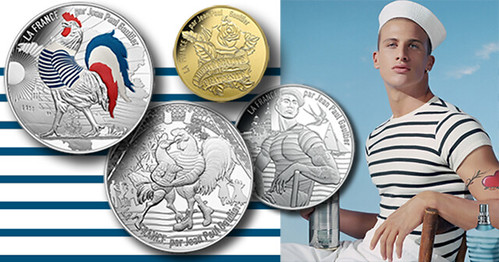
The Monnaie de Paris have unveiled their newest program of gold and silver coins, with an unexpected twist—they are designed by famed clothing designer Jean-Paul Gaultier, who is widely renowned as one of the more avant-garde luminaries in the world of fashion. In “La France par Jean-Paul Gaultier,” the designs of the twenty-four €10 coins (released in two collections of 12 each) are inspired by the cities, provinces, and regions of France as seen through his creative eyes. In addition to each 12-coin €10 collection is a pair of €50 silver coins, one un-colorised, one colorised. A €200 gold coin representing France’s strong symbols completes the series as a whole.
€50, First Design. This coin depicts a hen and a rooster at the 14th of July ball. Gaultier dresses one of France’s major national symbols, the rooster, and his girlfriend, the hen, in eye-catching ensembles of stripes and vivid prints, emblematic of Gaultier’s own clothing ranges. The rooster is wearing a marinière, and the hen, a corset—also iconic items of clothing for the fashion designer. They are dancing under the Eiffel Tower on the occasion of the National Day. (Uncoloured version, first collection)
€50, Third Design. Detailed and illustrated in full colour, the rooster is proudly wearing a marinière, his comb and feathers bear France’s national colours, as seen on the flag—blue, white, and red. In the background, we can see an outline of France and skyline and the sun’s rays. (Colour version, first collection)
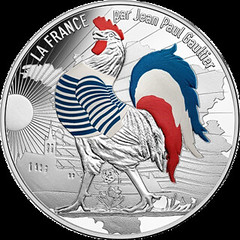
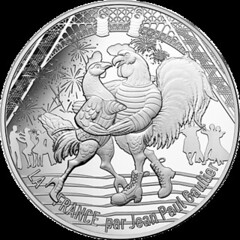
1st and 3rd silver coin designs
To read the complete article, see:
France: Famed haute couture designer Jean-Paul Gaultier
lends his talents for latest gold and silver coins (http://news.coinupdate.com/france-famed-haute-couture-designer-jean-paul-gaultier-lends-his-talents-for-latest-gold-and-silver-coins/)
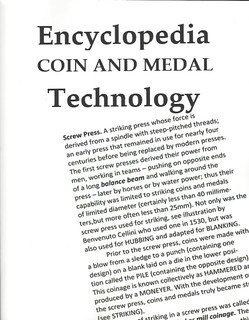
SORRY No more copies at $50.
Oh wait! It is not April 15 yet. I promised to sell my Encyclopedia for half price until April 15. Okay if your post marked letter and check are dated before April 15 you still get a copy postpaid. The full Encyclopedia is now on the Newman Numismatic Portal. If you prefer a printed copy (first edition) order now. No more printed. Few copies left.Order all three of my books and a new book from Spain.
Encyclopedia of Coin and Medal Technology
1,854 entries on every aspect of how coins and medals are made, cataloged and collected., Sample entries in recent E-Sylum issues as Vocabulary Words. Do not miss this opportunity! 678 pages, card cover. . . . .$50
Just published! El Numiscadero, English to Spanish and Spanish to English. By Gary Beals. I served as technical editor for this innovative work. Useful for all Spanish numismatics. Fully illustrated. Over 2,000 terms. 354 pages Card cover...$35
Monograms of American Coin and Medal
Artists. Identifies over 450 initials and monograms found on American coins and medals. 147 pages, card cover. . .. . . $45
Who’s Who Among American Medallists.
Biographies of 4,137 artists of American coins and medals, with some as long as 4 pages. With article of American Art Styles, bibliography 386 pages, Hard cover. . … $65
Dick Johnson 139 Thompson Drive Torrington, CT 06790
THE U.S. TREASURY DEPARTMENT MONEY LAUNDRY

Long before the term “money laundering” entered the popular lexicon, the U.S. Treasury Department had an actual laundry shop for grimy greenbacks. The mostly female “redemptive division” worked out of the basement and cleaned up to 80,000 soiled bills a day using mechanical scrubbers.
The idea of a cash laundry goes back to 1910, when the Director of the Bureau of Engraving and Printing (a division of Treasury) was searching for a way to extend the lifespan of paper money; at the time small denomination bills lasted just over a year before they were so worn out that they had to be retired.
A chemist at the bureau, Burgess Smith, came up with a mechanical device that could bathe, sterilize, and iron the grimy old bills with industrial efficiency. The invention took advantage of the fact that dollar bills are made out of a special blend of cotton and linen that doesn’t disintegrate in water.
A 1912 Washington Post account described how the laundry had “dozens of rolls, many gears, and operates with the same clash and clang [as a printing press]. The money is placed between two canvas belts at one end of the machine. It runs through a solution of laundry soap and boiling hot water, where it is thoroughly cleansed. It then enters another vat in which there is a solution of stiffening material and germ-killing solution. From this vat it is drawn between a gas heated mangle, where it is ironed as stiff as new bills.”
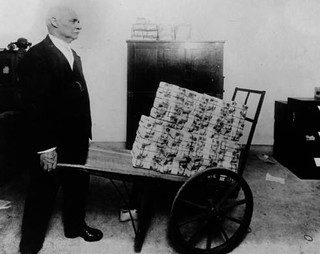 The money laundry saved the Treasury $250,000 a year in production costs, but not everyone was a fan of the cash cleaners. The Treasury printers’ union, for one, viewed the money laundry as
an existential threat. The printers used to be paid a piece rate for every sheet they completed, and the laundry shop threatened to reduce demand for new prints. Other white collar Treasury employees
resented the laundry for disturbing their workplace serenity. Back in the day, the Treasury building was half office, half factory, with the basement and attic filled with noisy printing presses.
Apparently, it got quite loud when everything was up and running.
The money laundry saved the Treasury $250,000 a year in production costs, but not everyone was a fan of the cash cleaners. The Treasury printers’ union, for one, viewed the money laundry as
an existential threat. The printers used to be paid a piece rate for every sheet they completed, and the laundry shop threatened to reduce demand for new prints. Other white collar Treasury employees
resented the laundry for disturbing their workplace serenity. Back in the day, the Treasury building was half office, half factory, with the basement and attic filled with noisy printing presses.
Apparently, it got quite loud when everything was up and running.
The nation’s bankers, for their part, thought that the laundry was great. Bills that went through the scrubber were softer than fresh notes—an important factor for people who spent their day counting money by hand.
The laundry shop used to be located in the basement of the Treasury Department, though nothing remains of it now, and it isn't clear where the particular room was. Tours of the Treasury Department can be arranged by submitting a request through your congressional office.
To read the complete article, see:
Treasury Department Laundry (www.atlasobscura.com/places/treasury-department-laundry)

DEFACING COINS LIKE A SUFFRAGETTE

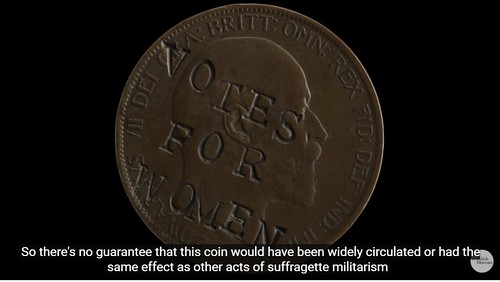
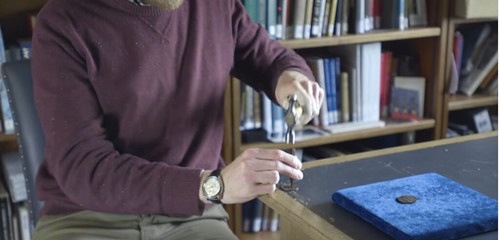
Flickr follower Stuart Williams of Ireland writes:
Political overstamping of current coins was also rife in Northern Ireland during the 1970s and 1980s. This was part of the period generally referred to as "The Troubles" in Northern Ireland when there was continual conflict between the Nationalist and Unionist factions. Each had their own paramilitary organisations such as the IRA and the UVF, as well as splinter groups off the same. Coins stamped with political slogans and name of organisations are commonly found on 5p, 10p and 50p coins.
Coins overstamped by the Unionist side tends to be more common than those from the Nationalist side. And, as you'd guess, Unionists defaced Irish coins and Nationalists defaced British coins with overstamping.
To watch the complete video, see:
Defacing coins like a suffragette | Curator's Corner Season 2 Episode 4 (www.youtube.com/watch?v=n1RmcRptMB4)
CONFERENCE EXAMINES COINS FOR THE DEAD
The conference “A coin for the dead, coins for the living. Charon’s obol: the end of a myth?” will be held at the Belgian School at Athens/Netherlands Institute at Athens on November 23-24, 2017, organized by Dr Jean-Marc Doyen (HALMA, Université de Lille 3), Dr Panagiotis Iossif (Belgian School at Athens), and Jean-Patrick Duchemin (PhD candidate at HALMA, Université de Lille 3).
Thanks to new methods of investigation, the field of funerary archaeology has developed in the last years. Fine excavation, precise archiving of contextual data and the many pluri-disciplinary studies have led to the establishment of an “archaeology of ritual”. Far from the simple gathering of material that excavating burials was confined to, this discipline now takes into account two essential things: biological anthropology and the study of taphonomic phenomena. The objects that were deposited in the tombs are then considered as part of the context in which the deceased is placed: in other words they can inform us on the funerary gestures.
Although the study of rites and gestures seems like an innovating field in archaeology, the taking into account of the data from the analysis of coins from funerary contexts has not yet followed this trend, despite the fact that this theme is undoubtedly at the heart of the renewal of funerary archaeology. The gesture of depositing one or more coins is indeed part of complex and various ritual sequences whose aim is the constitution of a tomb. Since the conferences held at Salerna (“Caronte. Un obolo per l’Aldila”, 20-22 Februrary 1995) and at Neuchatel (“Trouvailles monétaires de tombes”, 3-4 March 1995), which were thought of as pioneers on this matter, no new summary has been attempted on this practice nor on the integration of numismatic data within the funerary archaeology speech itself.
The aim of this conference is to revisit the question of monetary discoveries within burials through a contextual approach, incited by conceptual progress in the analysis of funerary documentation that has been made in the last years. This strictly anthropological approach aims at establishing a dialectical relationship between the facts that are precisely documented and their integration into a theoretical framework.
To read the complete article, see:
A coin for the dead – monetary discoveries within burials
(www.coinsweekly.com/en/News/A-coin-for-the-dead--monetary-discoveries-within-burials/4?&id=4634)
For a free subscription to CoinsWeekly, see: http://www.coinsweekly.com/en/Subscribe-to-CoinsWeekly-Newsletter/37

2016 AMERICAN MEDAL OF THE YEAR NAMED
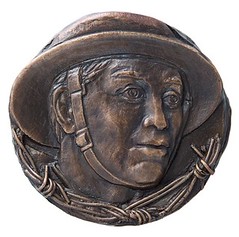
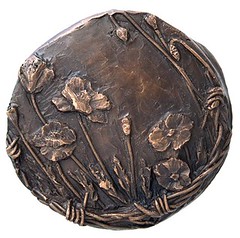
This year, there were 30 entries from 21 medalists for the American Medal of the Year (AMY) awarded by the American Medallic Sculpture Association (AMSA). Committee Chairman, Mel Wacks, indicates that “The jurors had a tough time choosing among many wonderful medals.” The winner is Remembrance by Susan Taylor of Ottawa, honoring the heroic efforts of the artist’s grandfather, George Edie and his fellow comrades who fought in the 2nd Battle of Ypres during the “Great War for Civilization."
Susan describes the medal: “The portrait of the young soldier framed by the barbed wire represents youth sacrificed through the loss of life, imprisonment and emotional trauma. On the reverse the poppies emerging from the barbed wire symbolize the loss of life through the spent flowers, the flowers in bloom: the survivors and the young buds: the future, lest we forget.”
The large 90mm bronze Remembrance medal will be limited to 45 pieces. Price is $125 plus $10 shipping (in Canadian dollars 150 plus 15 for shipping). To order contact Susan at susan.taylor@sympatico.ca.
The runner-up is Cicada Days & Firefly Nights by Lawrence Noble, for Brookgreen Gardens.
All of the AMY entries will be illustrated in the next AMSA newsletter. Medal collectors and medallists are invited to join by sending $40 (US & Canada) or $50 (Foreign) to AMSA, P.O. Box 1201, Edmonds, WA 98020.
CANADA COMMEMORATIVE $10 NOTE UNVEILED
 Bank of Canada Governor Stephen S. Poloz and Parliamentary Secretary to the Minister of Finance Ginette Petitpas Taylor today unveiled a commemorative $10 bank note celebrating the 150th
anniversary of Confederation. This special note—showcasing our history, land and culture—was revealed during a ceremony at the Bank’s head office in Ottawa. It will enter into circulation on 1
June.
Bank of Canada Governor Stephen S. Poloz and Parliamentary Secretary to the Minister of Finance Ginette Petitpas Taylor today unveiled a commemorative $10 bank note celebrating the 150th
anniversary of Confederation. This special note—showcasing our history, land and culture—was revealed during a ceremony at the Bank’s head office in Ottawa. It will enter into circulation on 1
June.
“This bank note is intended to captivate our imagination and instill pride in what we, as a nation, have accomplished,” said Governor Poloz. “It celebrates the natural beauty and majesty of our land and some of the important parliamentarians who helped shape our great country.”
The intricately designed note is unique in many ways. For the first time, four individuals are portrayed on the front of a Canadian bank note: Sir John A. Macdonald, Sir George-Étienne Cartier, Agnes Macphail and James Gladstone or Akay-na-muka—his Blackfoot name. With Parliament’s Hall of Honour in the background, these four parliamentarians remind us that Canada has been shaped by the vision, courage and effort of people of different backgrounds.
Upon circulation, the commemorative note will mark the first time that a Canadian woman and an Indigenous Canadian are depicted as portrait subjects on a Bank of Canada bank note. The design also incorporates Inuit and Metis cultural elements: a colourful reproduction of the artwork Owl’s Bouquet by world-renowned Inuit artist Kenojuak Ashevak; and the distinctive arrow sash pattern, an important symbol of the Métis nation.
“Canada’s diversity is our greatest strength,” said Ms. Petitpas Taylor. “As we celebrate Canada 150 we are reminded of what makes us who we are—from our shared history, to our cultures and languages to the breathtaking natural beauty that is instantly recognized around the world. On behalf of the Government of Canada I thank Governor Poloz and the Bank of Canada for their contribution to this truly national celebration.”
The Canada 150 note also showcases Canada’s natural beauty and unique landscapes. Five different landscapes representing the various regions of Canada are featured on the other side of the note: the Lions/Twin Sisters (Western Canada), a wheat field (Prairie provinces), the Canadian Shield (Central Canada), Cape Bonavista (Eastern Canada) and the Northern lights (Northern Canada).
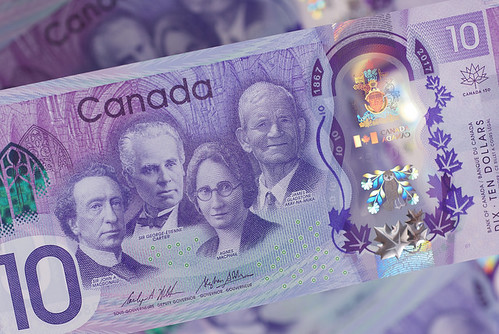
The commemorative $10 note also has new security features, including a colour-shifting arch depicting an arch found in the Memorial Chamber on Parliament Hill, as well as three-dimensional maple leaves.
The Canada 150 note will circulate alongside the current Polymer series $10 note, but it does not replace it. Both the current $10 note and the commemorative $10 note are of equal value and can be used interchangeably in transactions.
To read the complete article, see:
Bank of Canada unveils commemorative bank note to celebrate Canada’s 150th anniversary of Confederation
(www.bankofcanada.ca/2017/04/bank-canada-unveils-commemorative-bank-note/)
Bank of Canada - Banque du Canada (www.flickr.com/photos/bankofcanada/)
NEW €50 EUROPA SERIES BANKNOTE ISSUED
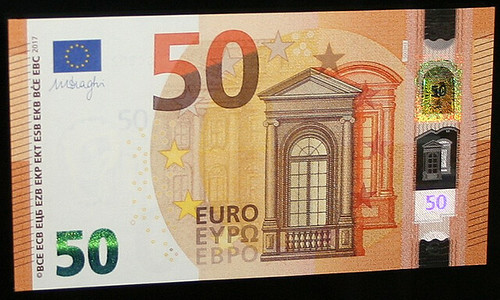
The European Central Bank announced today (4th April) that the new €50 banknote in the current “Europa” series has been officially released for circulation. The new banknote was unveiled at the headquarters of the European Central Bank (ECB) on the 5th July 2016, when ECB executive member Yves Mersch introduced the note’s new security features and amended design. The current “Europa” series was first introduced in 2014 with the re-design of the €5 banknote. According to the ECB, the re-designed series includes “the countries that have joined the EU since 2002. For instance, the map of Europe shows Malta and Cyprus, “euro” is written in Cyrillic in addition to the Latin and Greek alphabets, and the initials of the ECB appear in ten—instead of five—linguistic variants.”
The new ECB notes’ integrated, revised security features include a portrait window depicting an image of Europa on both sides of the note; the window becomes transparent when held against a light. A hologram strip contains images of the number 50, another image of Europa, and the primary architectural design of the €50 note. Additional, enhanced security features also include a printed “emerald” number, which displays an effect of the light moving up and down when the note is tilted. Raised print assists the visually impaired.
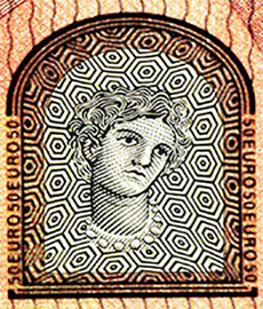
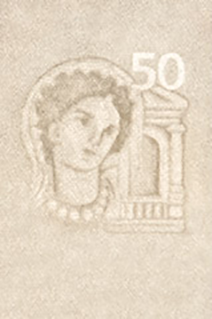
The €50 is the most widely used euro-banknote denomination. With over 9 billion of them in circulation, they account for 46% of all euro banknotes. The €50 banknotes of the first series will remain legal tender and continue to circulate alongside the new notes. The first-series €50 note will be gradually withdrawn from circulation but is always redeemable at the offices of central and national banks and commercial banks within the eurozone, presently without time limit.
The European Central Bank have announced that new €100 and €200 “Europa” series banknotes will be issued at the beginning of 2019.
To read the complete article, see:
European Union: New €50 “Europa” series banknote issued today
(http://news.coinupdate.com/european-union-new-e50-europa-series-banknote-issued-today/)
BANK OF ENGLAND £5 NOTE DEADLINE APPROACHES
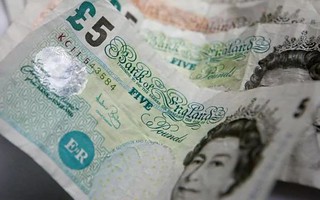 It does not seem long ago since the new polymer £5 notes were introduced.
It does not seem long ago since the new polymer £5 notes were introduced.
But people have just weeks left to spend - or bank - the 160 million paper fivers still in circulation before they lose their legal tender status.
From Friday, May 5, shops no longer have to accept the paper fiver featuring prison reformer Elizabeth Fry as payment.
And not all banks and building societies will accept the old notes being returned.
After May 5, the new polymer banknote - billed as untearable and with enhanced security when introduced last September - featuring Sir Winston Churchill will be the only Bank of England £5 note with legal tender status.
A spokesman for the Committee of Scottish Clearing Bankers, which represents Bank of Scotland, Clydesdale Bank and Royal Bank of Scotland, said: "The paper Scottish fivers are not being withdrawn from circulation, they are just not being reissued.
"They don't have a withdrawal date as such similar to the English £5 notes."
To read the complete article, see:
You only have weeks to spend your old £5 notes - or even banks might not take them
(www.telegraph.co.uk/news/2017/04/05/have-weeks-spend-old-5-notes-even-banks-might-not-take/)
MICRO-PORTRAIT ARTIST EYES NEW POUND COIN
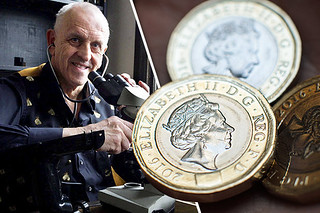 Graham Short’s miniature artwork sells for fortunes at auction, which is why his extremely rare engraved £5 notes have been sold for up to £50,000.
Graham Short’s miniature artwork sells for fortunes at auction, which is why his extremely rare engraved £5 notes have been sold for up to £50,000.
Now Graham has exclusively told Daily Star Online that he is planning to put a miniature engraving on four of the newly released £1 coins.
He said: “I picked up ten new £1 coins yesterday and I’m seriously thinking about doing something with them.
He added: “I’ve had the pound coin under the microscope and it’s a very soft to cut into, much softer than I thought it would be. They’re quite easy to work on.”
Graham, 70, is best known for his miniature engravings, including his smallest work – the words “Everything is Possible” in Russian carved along the sharp edge of a razor blade.
Last year he caused a stir by revealing that he had spent four £5 notes with his highly-sought after artwork all around the country.
He spent the notes – which can fetch around £50,000 at an auction – in England, Scotland, Wales and Northern Ireland.
Now Graham says he wants to do exactly the same thing with four of the new quid coins.
He told Daily Star Online that he thinks the new one pound coin artwork will take a long time and he does not know when he will finish.
To read the complete article, see:
REVEALED: Handful of new £1 coins to be worth THOUSANDS
as £50k fiver creator reveals plan (www.dailystar.co.uk/news/latest-news/601473/New-one-pound-coin-five-pound-note-new-worth-value-Graham-Short-art-engraving-2017)
To read earlier E-Sylum articles, see:
ARTIST ENGRAVED QUEEN'S PORTRAIT ON PINHEAD (www.coinbooks.org/esylum_v19n51a31.html)
ARTIST SPENDS BILL ENGRAVED WITH MICRO-PORTRAIT (www.coinbooks.org/esylum_v19n51a30.html)
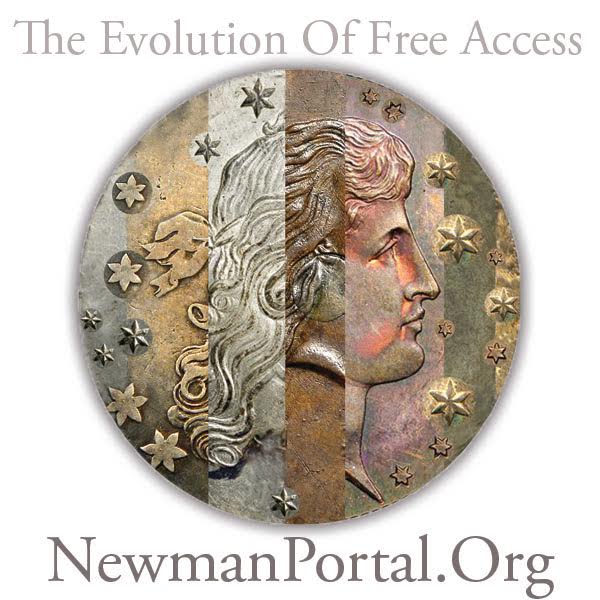
ARTICLE PROFILES IMAGES OF VALUE EXHIBIT
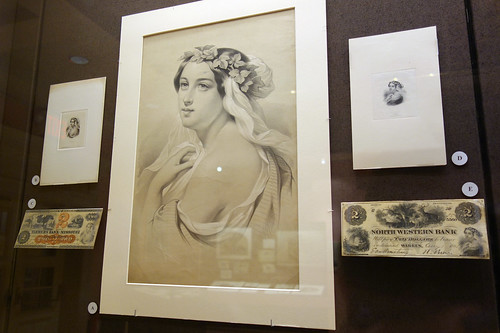
Before the United States produced the Hudson River School or paintings of the American Frontier, the new country proved its artistic might on banknotes. Images of Value: The Artwork Behind U.S. Security Engraving, 1830s–1980s at the Grolier Club chronicles 150 years of this history, with over 250 paintings, drawings, etchings, banknotes, and stock certificates, along with currency from 15 countries. Mark D. Tomasko, who collected most of the works on view, notes in an introduction that security engraving “was one of the first arts in which the United States became a world leader.”
Tomasko explained to Hyperallergic that his interest in security engraving spawned from collecting coins, which he started doing at the age of 10. “Within four or five years, I became interested in banknotes.” At the time, “three different kinds of paper money were circulating”: green-seal federal reserve notes that survive today, red-seal US notes, and blue-seal silver certificates. “Still later, when my grandmother gave me some stock certificates of the Marmon Motor Car Company [1920s–30s], I discovered securities, as they were the largest format for banknote engraving. By the late 1960s I was interested in the engraving on the banknotes and securities — who did it, how was it done, and where the artwork came from.”
There were several factors that contributed to the success of this financial fine art in the US, including the quality of engraving firms in Philadelphia and New York as well as a system that allowed nearly all American banks to issue their own notes. And the more expertly executed the security engraving, or “vignette,” the harder to counterfeit the note or bond. The exhibition at the Grolier Club begins with early 19th-century pastoral scenes, including work by Asher B. Durand, who worked in banknote art before concentrating on landscape paintings, and progresses up to the 1960s–80s, when artists like Robert Lavin were modernizing allegorical figures to represent new technology and industry.
To read the complete article, see:
How Art Secured American Banknotes for 150 Years (https://hyperallergic.com/366073/grolier-club-images-of-value/)
To read the earlier E-Sylum articles, see:
NEW BOOK: IMAGES OF VALUE (www.coinbooks.org/v20/esylum_v20n09a03.html)
NEW YORK TIMES REVIEWS IMAGES OF VALUE EXHIBIT (www.coinbooks.org/v20/esylum_v20n09a21.html)
FEATURED WEB SITE: AMERICAN MEDALLIC SCULPTURE ASSOCIATION
This week's Featured Web Site is he American Medallic Sculpture Association.Founded in 1982, the American Medallic Sculpture Association (AMSA) works to encourage the creation, study and appreciation of the American Fine Art Medal.
All who are interested are welcome as members. Our goal is to increase awareness of medallic sculpture, to assist artists, collectors and scholars alike in their quest to share and disseminate knowledge of this hand held form of artistic expression.
The purpose of the American Medallic Sculpture Association (AMSA) is to encourage the creation and study of medallic sculpture in North America. All who are interested are welcome as members. Our aim is to disseminate information and add impetus in making medallic sculpture a vital and viable art form in this country.

www.amsamedals.org

